Here we'll explore some of the best telescopes for astrophotography that we've reviewed over the years.
When setting out to capture images of the night sky for the first time, most people probably start by thinking what sort of camera they need.
When in fact making sure you have the right sort of telescope for astrophotography is just as important, if not more so.
Whether you're a beginner or a seasoned astronomer, it pays to do a bit of research as to what type of telescope you'll need to photograph the night sky.
Jump to:
Best telescopes for astrophotography
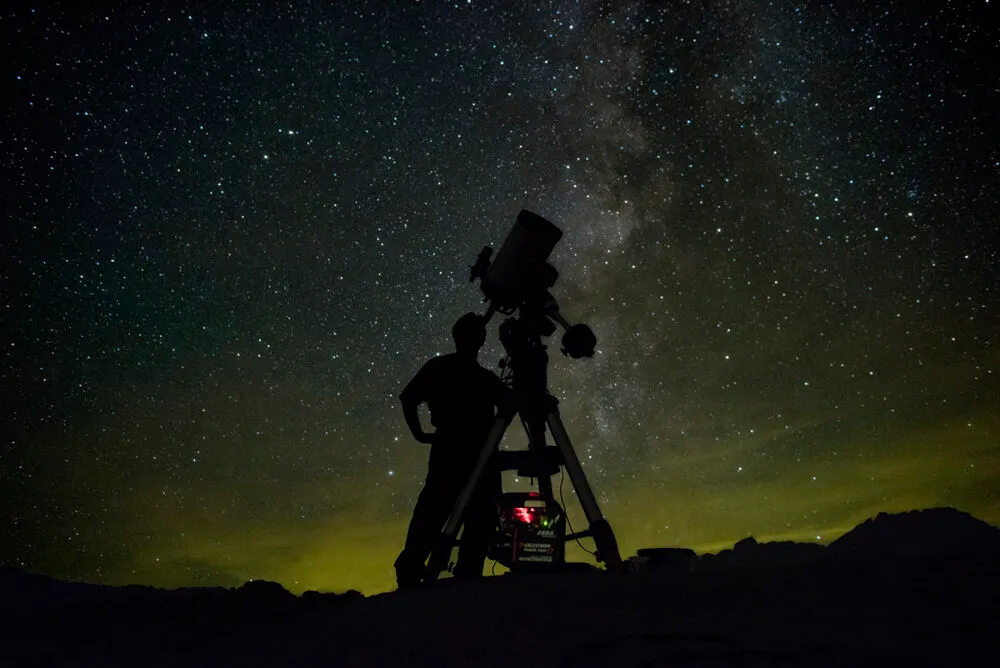
And as is the case with visual observing, the best astrophotography telescope for you will depend on what sort of targets you want to photograph.
You will also need to consider what you're going to mount your telescope on, as it will need to track your object as it moves across the sky, and this is especially the case for deep-sky astrophotography where longer exposures are required.
For more on this, read our guide to telescope mounts.
Read on for our guide to everything you need to know to photograph the Moon, the planets and deep-sky objects like galaxies and nebulae, and our pick of some of the best telescopes for astrophotography.
Deep-sky astrophotography Masterclass
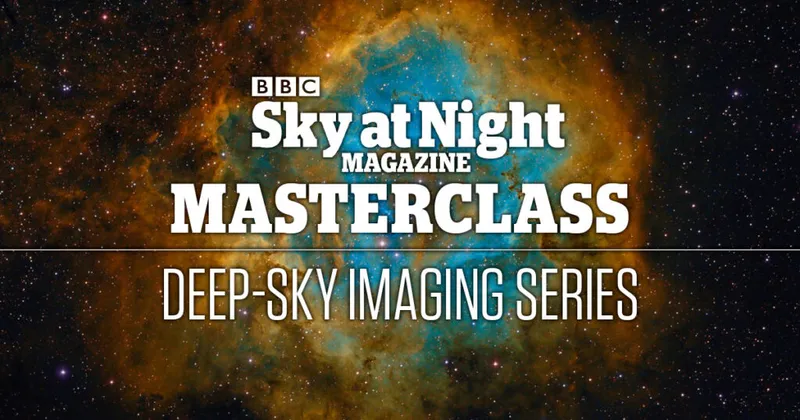
Interested in astrophotography? Sign up for our Deep-Sky Imaging Masterclass and find out how to capture distant galaxies and nebulae.
Click here to book tickets for all three Masterclasses and save 20%
Understanding focal ratio

When choosing a between the best telescopes for astrophotography - or, indeed, for visual observing - it pays to consider the focal ratio of the instruments available.
Focal ratio (f-ratio) gives an indication of the ‘speed’ of an optical system: the time it takes your telescope to deliver a set amount of light.
As the f-ratio goes up, so the image scale increases: the object appears larger and consequently dimmer.
So f-ratio is a key value that will help you choose which telescope to use for a specific type of astronomical target.
The f-ratio is defined by dividing your telescope’s focal length by its aperture, using the same units.
So if you have a 100mm refractor with a focal length of 900mm, its f-ratio is said to be f/9.
Adding a 2x Barlow lens increases the effective focal length to 1,800mm and doubles the f-ratio to f/18, but there is a limit to how much focal length is useful.
Telescopes for photographing the Moon

DSLR cameras are a great choice for photographing the Moon, and because they have detachable lenses they can be connected directly to a telescope, turning the scope into the camera lens.
This requires a T-adaptor and a T-ring. The ring mounts on your DSLR and screws into the adapter, which then attaches to your telescope.
For high-resolution lunar imaging, you may want to use a high frame rate planetary camera.
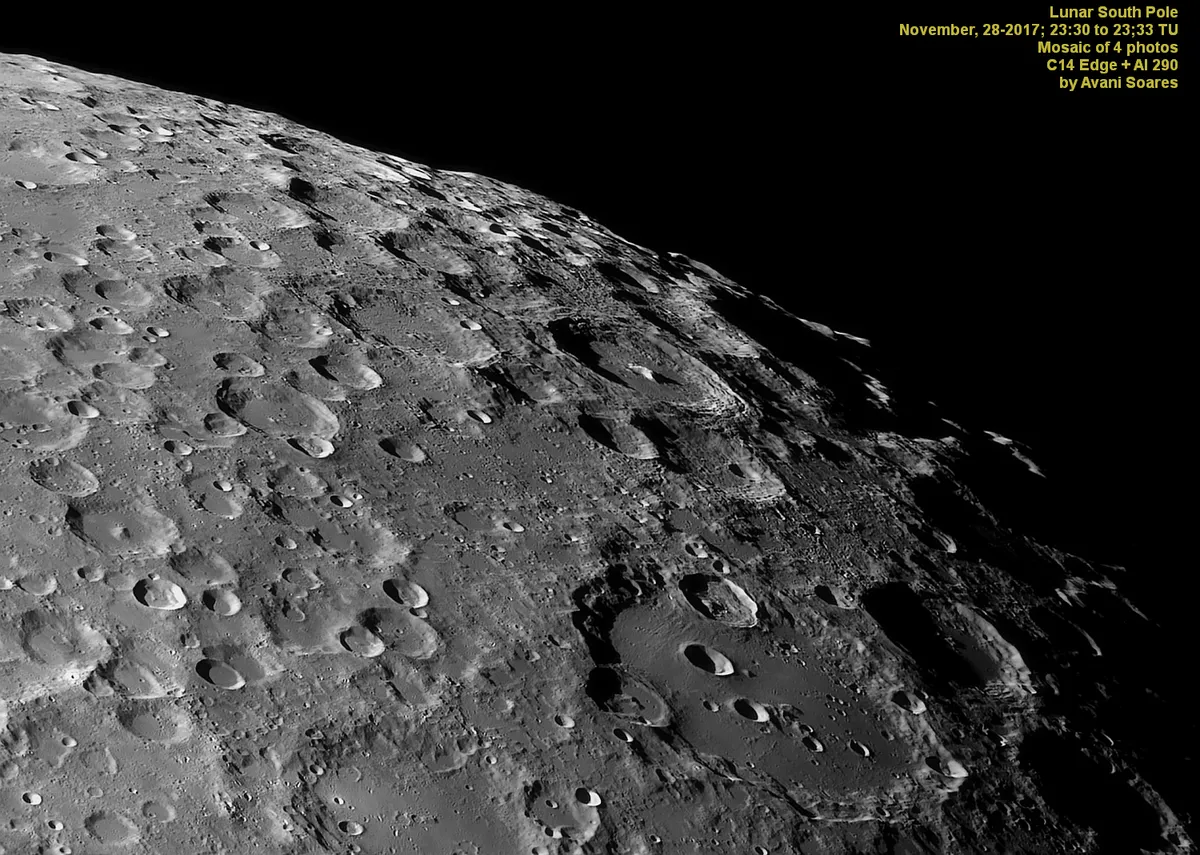
You can use any good quality telescope to photograph the Moon, including any on our best telescopes for astrophotography list.
But large aperture Schmidt-Cassegrains and Maksutov-Cassegrains are popular choices with lunar photographers.
Their longer focal lengths are suited to close-up imaging of the Moon, and compared to a high-quality refractor telescope you get a much larger aperture for your money.
Whatever type of telescope you use to photograph the Moon, make sure it’s well collimated if need be.
Your mount should be stable and sturdy and the ability to track the Moon with a motor drive or with a Go-To mount is a must when using a high frame rate camera.
Make sure the drives are tracking at the lunar rate, not the rate at which the stars move across the sky.
Telescopes for photographing planets

You need a telescope with quite a bit of magnification to photograph surface details on your chosen planet.
To see more detail, you need to increase the magnification or image scale (how big an object appears in the image frame).
This is determined by the focal length of your telescope. As a telescope’s focal length is fixed, you might think that it can only give one magnification, but this isn’t the case.
Optical amplifiers such as a Barlow lens can effectively increase it, while focal reducers effectively lessen it.
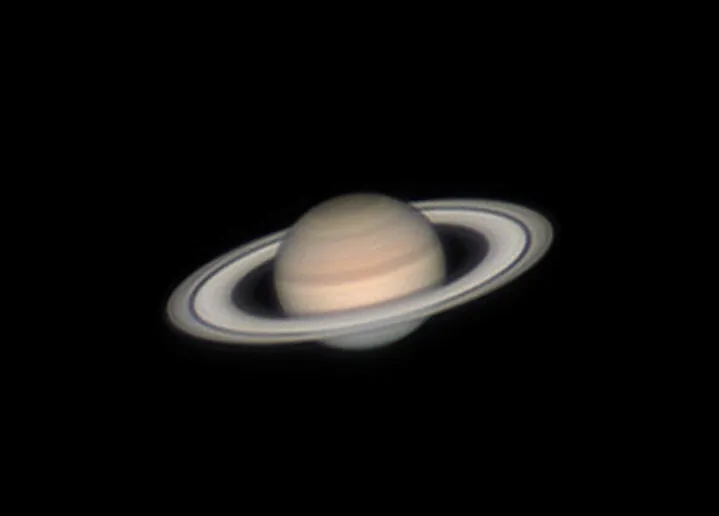
In terms of your telescope's focal ratio (see above), large values make the image appear dim and require lower frame rates and longer exposures, and beyond a certain value your telescope won’t be able to deliver any more useful detail.
Under average seeing conditions, figures of f/15-f/25 will probably work best.
If you are lucky enough to experience excellent seeing, values in the f/25-f/45 range can be effective.

A key skill when photographing the planets is knowing how to select the best image scale for the prevailing conditions.
Apertures of 8 inches or larger are best for high-resolution planetary imaging, and the best telescopes for astrophotography in this respect would be large aperture, long focal length, colour-corrected (apochromatic) refractors.
This kind of scope is great for providing the unobstructed high-contrast views necessary to reveal detail on a planet’s disc.
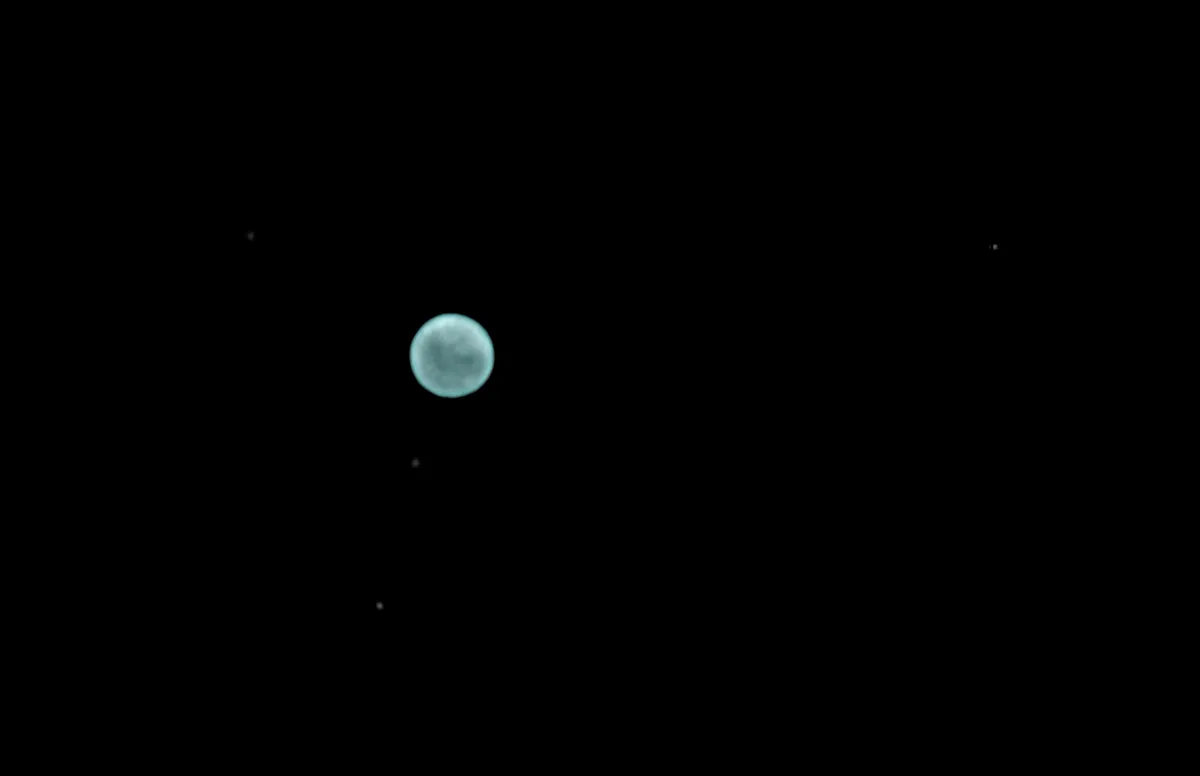
Reflecting telescopes can also be excellent planetary scopes, but to get high image scales you need a long focal length instrument.
As aperture increases, such an instrument can become heavy and cumbersome, making it difficult to mount and handle.
One popular design for planetary astrophotography is the catadioptric scope, which uses both mirrors and lenses.
The Schmidt-Cassegrain design balances size and performance with affordable cost.
And since the optics of this kind of scope effectively ‘fold’ the light path, a large aperture, long focal length Schmidt-Cassegrain is also fairly easy to handle.
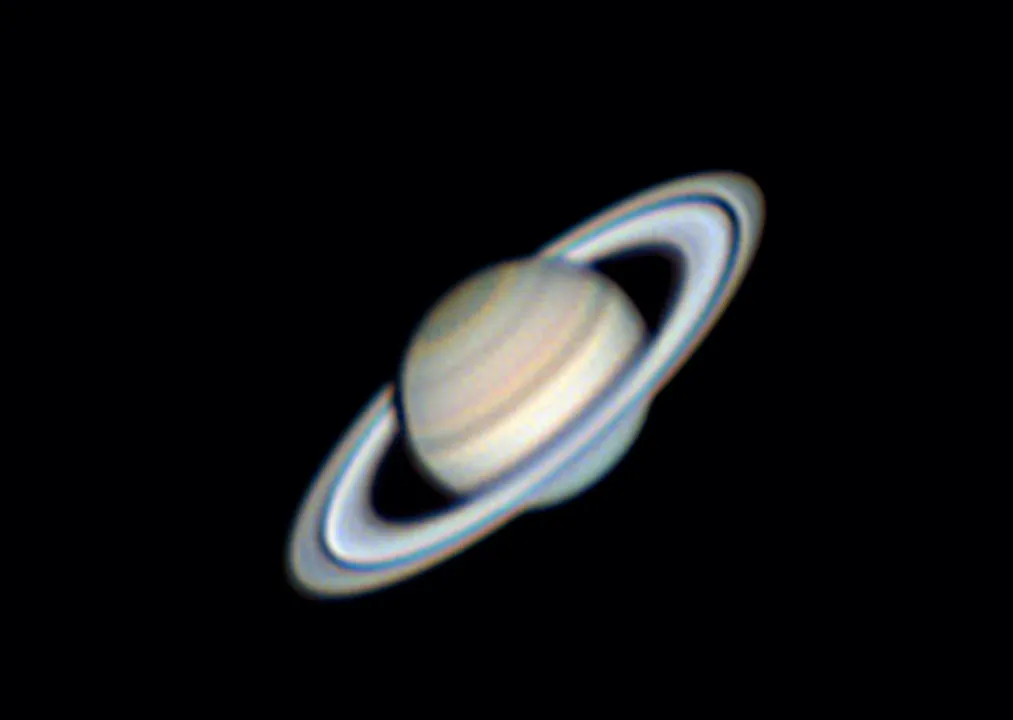
You’ll also need a solid mount for planetary imaging. Ideally an equatorial design, polar aligned with driven right ascension and declination axes.
If you have a smaller telescope, don’t worry: telescopes under 8 inches in aperture are capable of capturing some detailed shots under the right conditions.
The key is to keep the image scale realistic for the size of the scope and conditions.
A family portrait of Jupiter with its four Galilean moons, for example, can be just as stunning as a close-up.
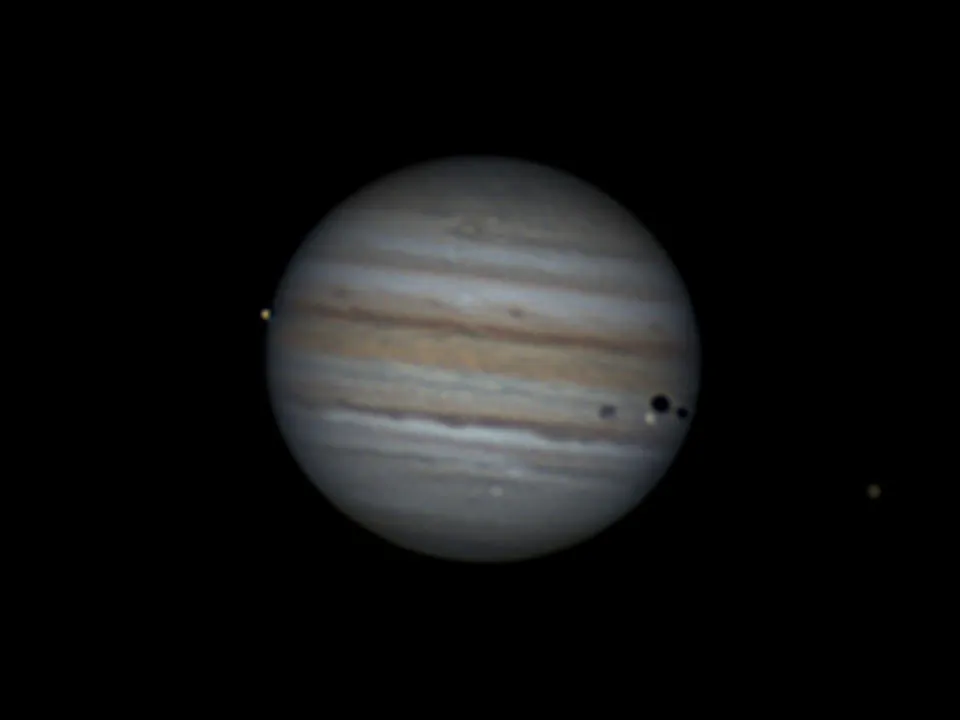
Telescopes for photographing galaxies
It’s a common assumption that you need a large and powerful telescope for deep-sky imaging.
Since many deep-sky objects are rather large, smaller, short focal length telescopes with wider fields of view can be very effective, especially for regions of nebulosity that are particularly extensive.
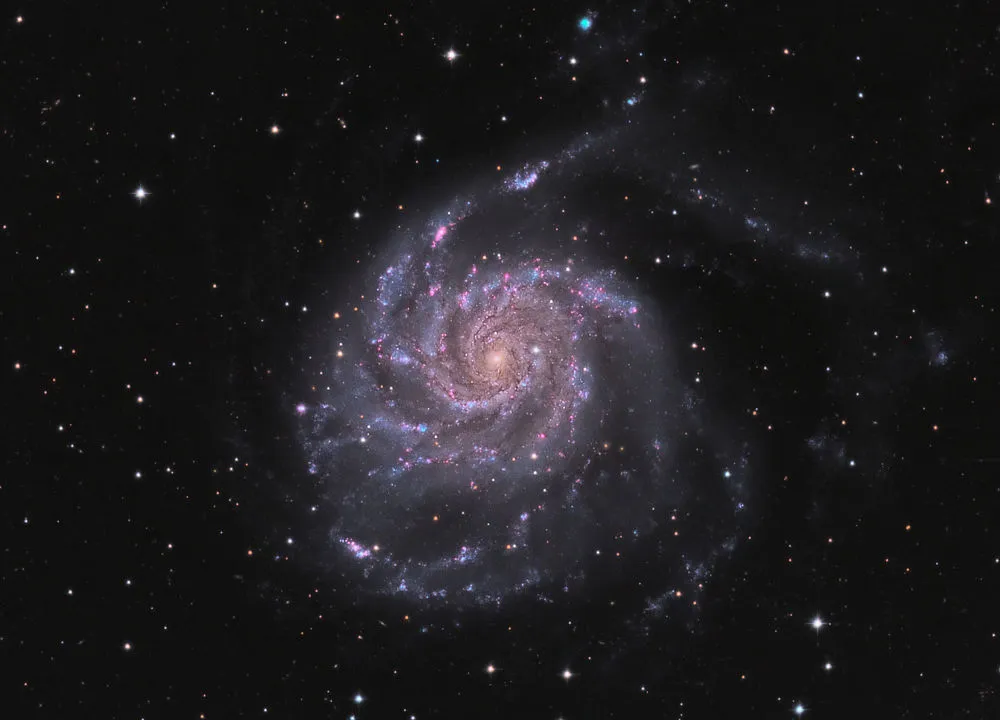
Although the old adage 'there’s no substitute for aperture' is valid for observing deep-sky objects, it’s not quite so important for imaging, as you can compensate for smaller apertures with longer exposures.
The larger the telescope, the greater the loading on the mount; the heavier the load, the more work the mount will have to do to track properly.
Longer focal lengths will also put greater demands on a mount’s tracking abilities.
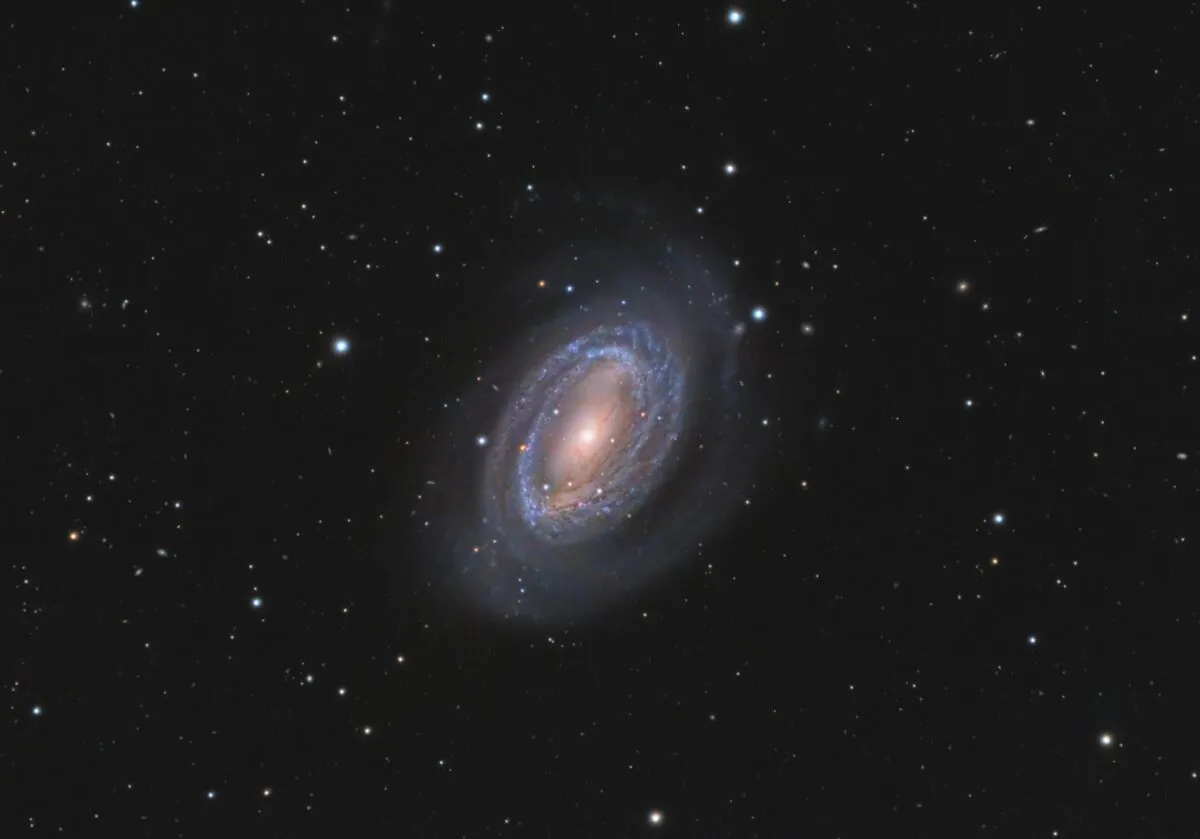
Small tracking errors are amplified by long focal lengths, so choose your telescope carefully to get the most from your system and to ensure that your mount and telescope are well matched.
If your main interest lies in galaxies and globular clusters, then their relatively small apparent size will mean that a longer focal length telescope is a good choice to photography them in detail, so consider a Schmidt-Cassegrain instrument or Newtonian reflector.
These objects do look great in a wider field of view, though, which enables you to see them in a wider setting.
Telescopes for photographing nebulae
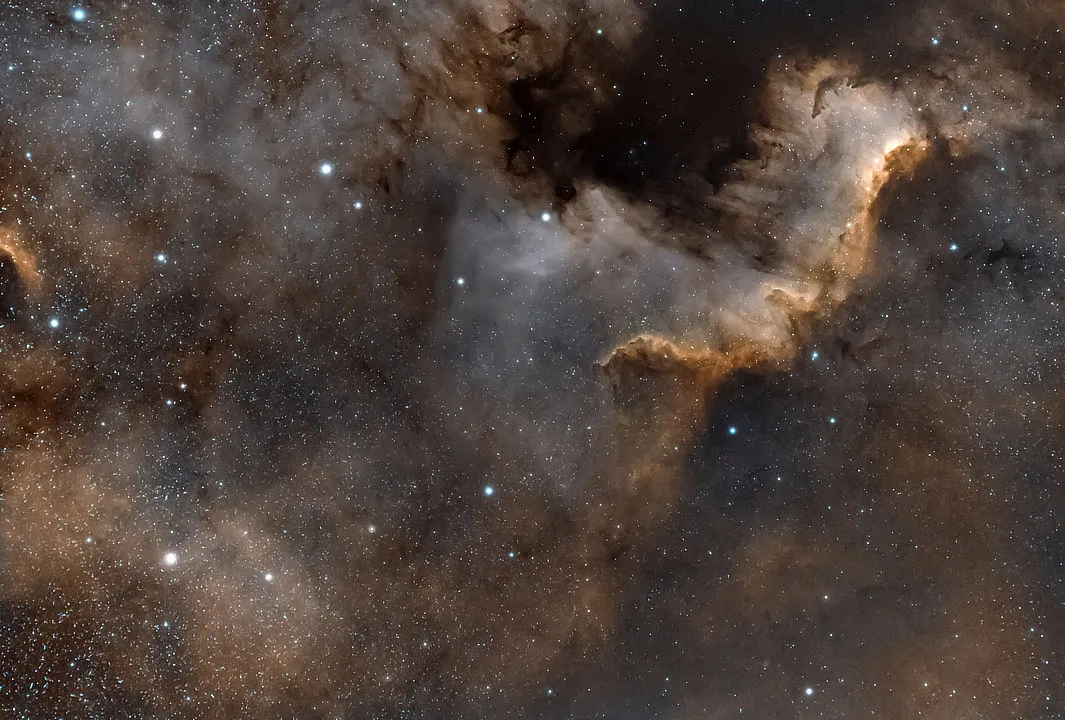
If your interests are more nebula-based, a short focal length refractor would be a good choice for photographing nebulae.Many deep-sky imagers find a 3- or 4-inch refractor perfect for this purpose.
The advantage of using a small refractor is that it will place fewer demands on your mount, both in terms of load-bearing and tracking performance.
This is why many established imagers recommend these instruments to people starting out on the imaging road.
Can one telescope do all astrophotography?
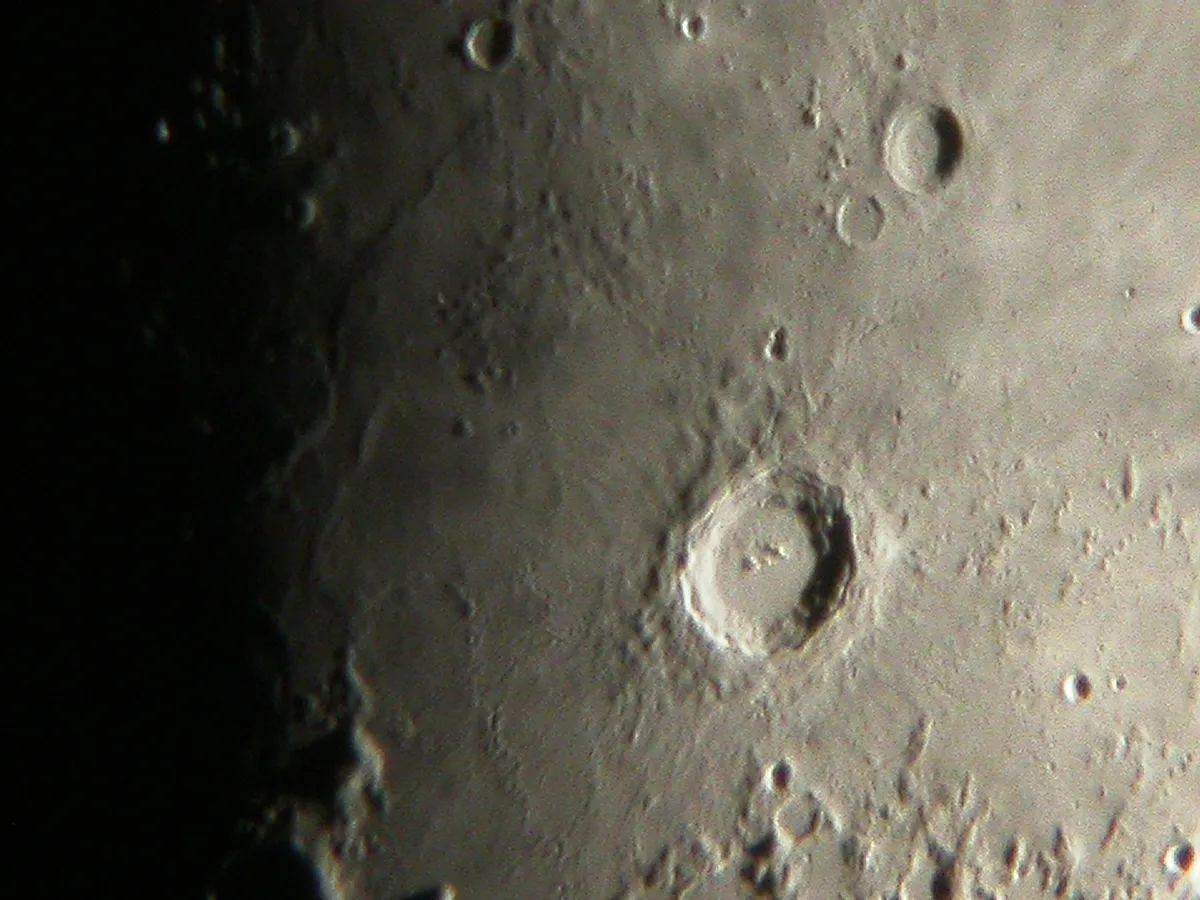
Below is our list of the best telescopes for astrophotography, and some are especially good at imaging specific kinds of targets.
Is there one telescope that's good for all astrophotography?
If your interests are polarised between planetary or lunar observations and deep-sky imaging, a Schmidt-Cassegrain with a focal reducer-field flattener will cover a lot of the astrophotography ground.
Armed with this knowledge, it's time to take the plunge! But which are the best telescopes for astrophotography?
We've reviewed quite a lot of telescopes over the years, and below we've picked out some of the best astrophotography telescopes for beginners and experienced imagers alike.
How we test the best telescopes for astrophotography
Ease of use
Is the product difficult to use with poor or no instructions? Perhaps it achieves its goal, but not easily.
Positive reviews come about because the product does a good job, but there may still be changes to the design or accessories that could make it easier to use.
Very positive reviews come about because the telescope is easy to use with supplied instructions and only a few minor issues.
Occasionally we find the product is very easy to use with no improvement needed.
Features
When considering the telescope's features, we'll take into account what features are present and whether they're up to the job.
A telescope may have useful features, but they may not perform very well.
Perhaps there is a wide range of features that make the telescope enjoyable to use, but some useful features are missing that could have been included.
If we discover a good range of useful features that enhance the user experience, our review will generally be positive.

Imaging quality
When testing the best telescopes for astrophotography, we spend our evenings imaging available objects in the night sky at the time of year.
If the scope has a poor build quality we'll pick up any optical aberrations present and whether it has a poor focuser.
We test collimating and whether its cooling properties are sufficient for planetary imaging.
We look for a sturdy construction with adequate focuser, few aberrations and good thermal cool-down .
Positive reviews will likely be a result of good build quality, good focuser with dual speed capability and minor aberrations at the edge of the field of view.
Optics
Optics, of course, are key. We check for errors such as out-of-focus stars and whether multicoatings are present.
If we discover a small number of optical aberrations, but the central 50% provides a good view, we'll be relatively happy.
But ideally we want to see very good optics with only slight optical aberrations apparent, and multicoated surfaces where applicable.
29 best telescopes for astrophotography
Sky-Watcher Evolux 82ED refractor
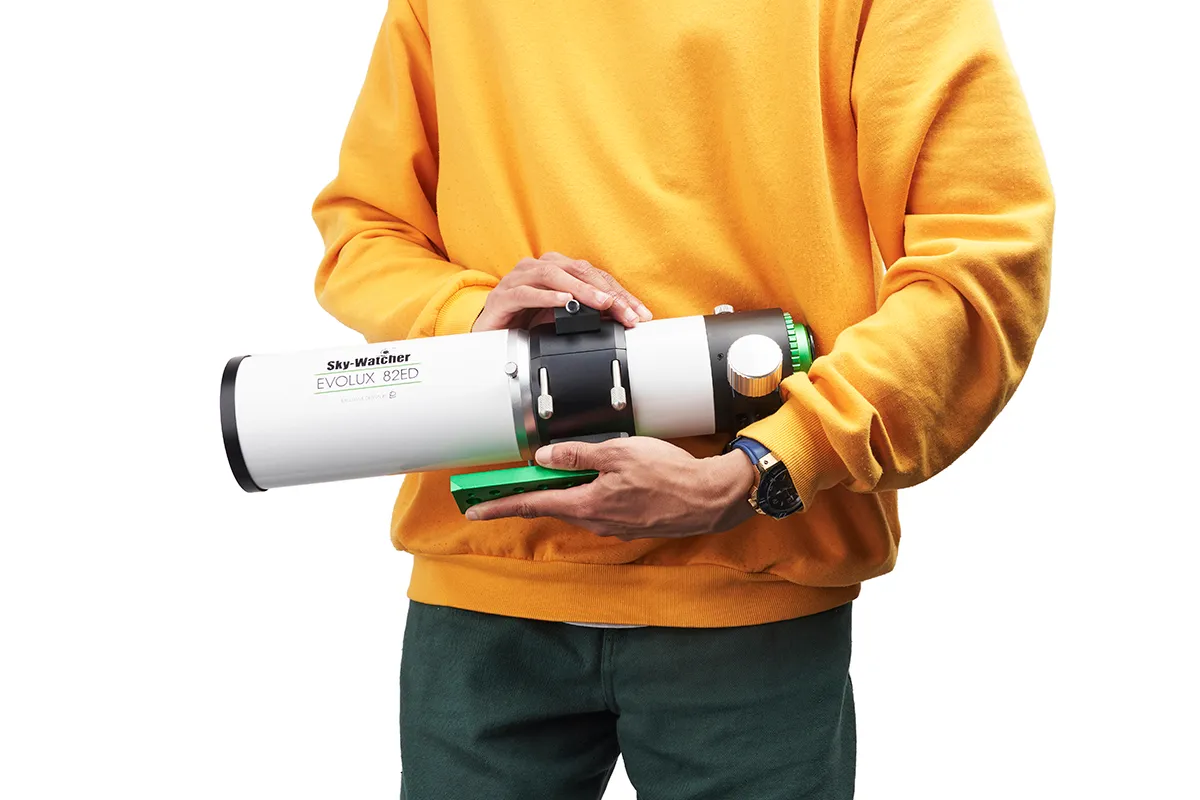
The Evolux 82ED’s weight and dimensions make it a portable grab-and-go telescope suitable for astrophotography.
During testing, we ran a 30-second exposure and found a very flat image with round stars across the majority of the field.
Stacked images revealed crisp nebulae and a surprising amount of fainter detail for only an hour of exposure time per target.
At 530mm focal length (f/6.45) native or 477mm (f/5.8) with optional focal reducer, the ED82 offers a good range.
The longer end, when paired with smaller-chip cameras, will capture galaxies, smaller nebulae and globular clusters.
Adding the optional focal reducer brings larger nebulae and galaxies into play.
Key specs
- Optics: air-spaced doublet refractor with ED lens
- Aperture: 82mm
- Focal length: 530mm, f/6.45
- Focuser: CNC-machined dual-speed rack and pinion
- Extras: tube ring, Vixen-style dovetail bar, 2x finderscope brackets, carry case, 2-inch eyepiece adaptor
- Weight: 2.9kg
Read our full Sky-Watcher Evolux 82ED refractor review.
Celestron 114LCM computerised telescope

The Celestron 114LCM has a 4.5-inch mirror and a focal length of 1,000mm giving a focal ratio of f/9.
The 114LCM makes for a great planetary imager. We were able to capture a wonderful image showing Saturn and a crisp view of its majestic rings.
Turning to the Moon, we were able to undertake an 8-panel Moon mosaic showing off great detail on the lunar surface.
The 114LCM is not suited to deep-sky imaging, but is certainly one to go for if your interestes lie closer to home, within our Solar System.
It offers good optics and a computerised mount that can point straight to your chosen target with the touch of a button.
Key specs
- Focal length 1000mm (f/9)
- Weight 5kg (OTA 2kg)
Read our full Celestron 114LCM computerised telescope review.
Tecnosky AG70 astrograph
- Buy now from Astro Shop

The TecnoSky AG70 is designed to help astrophotographers capture images with as little fuss as possible, and it goes along way to fulfilling this brief.
It has an optical system designed to eliminate issues with star shapes and colour problems and removes the need to use a coma corrector.
The AG70 has a focal length of 350mm, making it great for capturing extended objects and large nebulae. A fast f/5 focal ratio allows for short exposures, which is good news for those using DSLR cameras.
Plus, considering the AG70 measures just 310mm and weighs 2kg, it's a portable telescope, making it a good option for astrophotography sessions in far-flung sites.
Key specs
- Optics Flat-field quadruplet with Lanthanum and FPL-53 elements
- Aperture 70mm (2.75 inches)
- Focal length 350mm (f/5)
- Focuser Dual-speed rack and pinion with tilt adjustment
- Extras Eyepiece adaptor, tube rings, dovetail, finder shoe
- Weight 2.1kg
Read our full Tecnosky AG70 astrograph telescope review.
SharpStar SCA260 Aspherical Cassegrain Astrograph
- Buy now from AliExpress
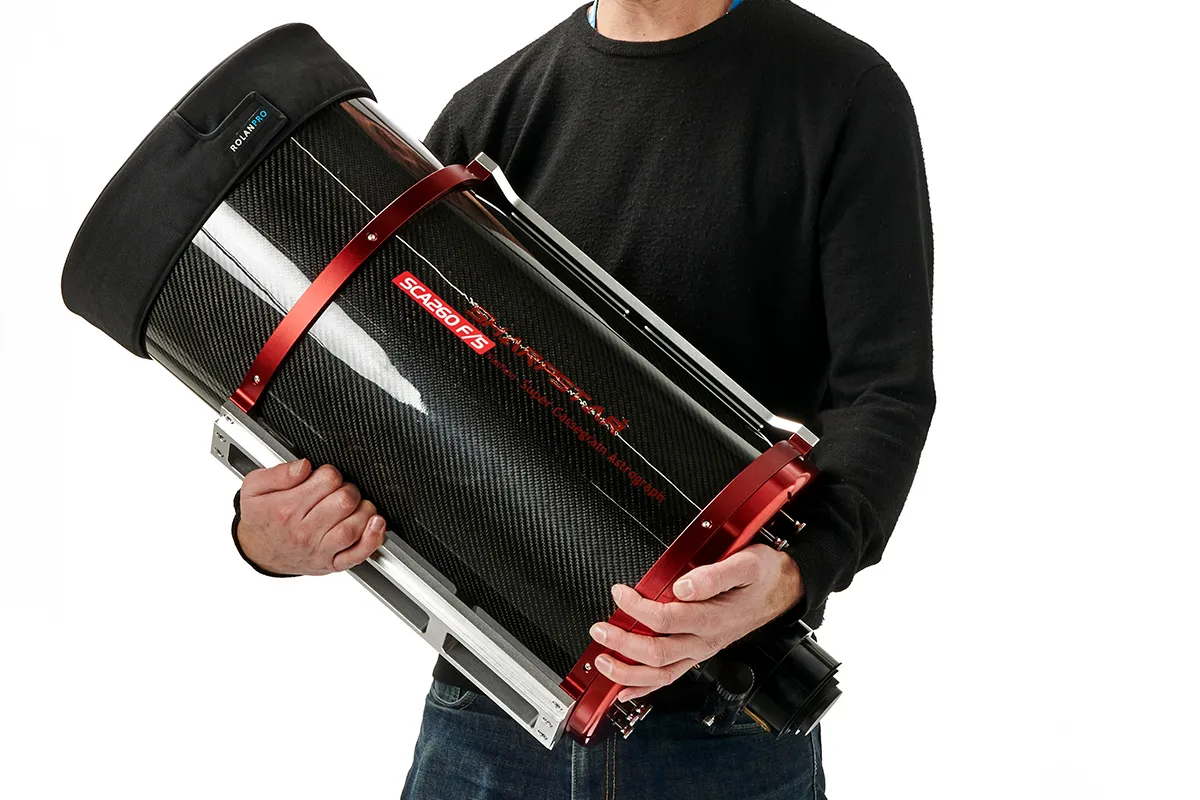
At over 700mm long and 280mm wide and weighing 15kg - without camera or guiding equipment - this is a serious instrument for dedicated astrophotographers, but among other similar telescopes it boasts a relatively low price tag.
Its optical arrangement makes the SCA260 suitable for a wide range of astrophotography cameras.
Using a full frame colour CMOS, we were able to capture a large target like the Pleiades in its entirety, with beautiful diffraction spikes on the brightest stars.
Turning to a smaller sensor camera we got lovely images of galaxies like NGC 891. It's these sorts of images that first got us interested in astro imaging.
Smaller deep-sky objects like the Cigar Galaxy and the Dumbbell Nebula showed good detail and a close-up field of view.
Key specs
- Optics: Corrected Aspherical Cassegrain
- Aperture: 260mm
- Focal length: 1,300mm, f/5
- Focuser: 3-inch rack and pinion
- Tube material: Carbon fibre
- Weight: 15kg
Read our full SharpStar SCA260 Aspherical Cassegrain Astrograph review.
Explore Scientific ED127 apo refractor

The ED127’s air-spaced triplet is ideal for getting good views of faint deep-sky objects and for finer details on the planets and the Moon.
A focal length of 952mm gives it a focal ratio of f/7.5.
During our imaging run we found good consistency across a non-full frame DSLR sensor at prime focus.
The ED127 also makes for a good medium-resolution planetary imaging instrument, and we acquired some lovely detail in our lunar images when paired with a high frame rate camera.
We photographed the lunar surface at prime focus through a red, green and blue filter without re-focusing between filters.
We were impressed with the results: combining individually filtered data didn’t introduce any noticeable colour fringing.
Key specs
- Aperture 127mm (5inches)
- Focal Length 952mm, f/7.5
- Eyepieces 25mm 2-inch eyepiece
- Finderscope 8x50 right-angled illuminated finder
- Weight 8.1kg without diagonal/eyepiece
Read our full Explore Scientific ED127 apochromat refractor review.
Unistellar eVscope eQuinox
- Buy now from Focus Camera
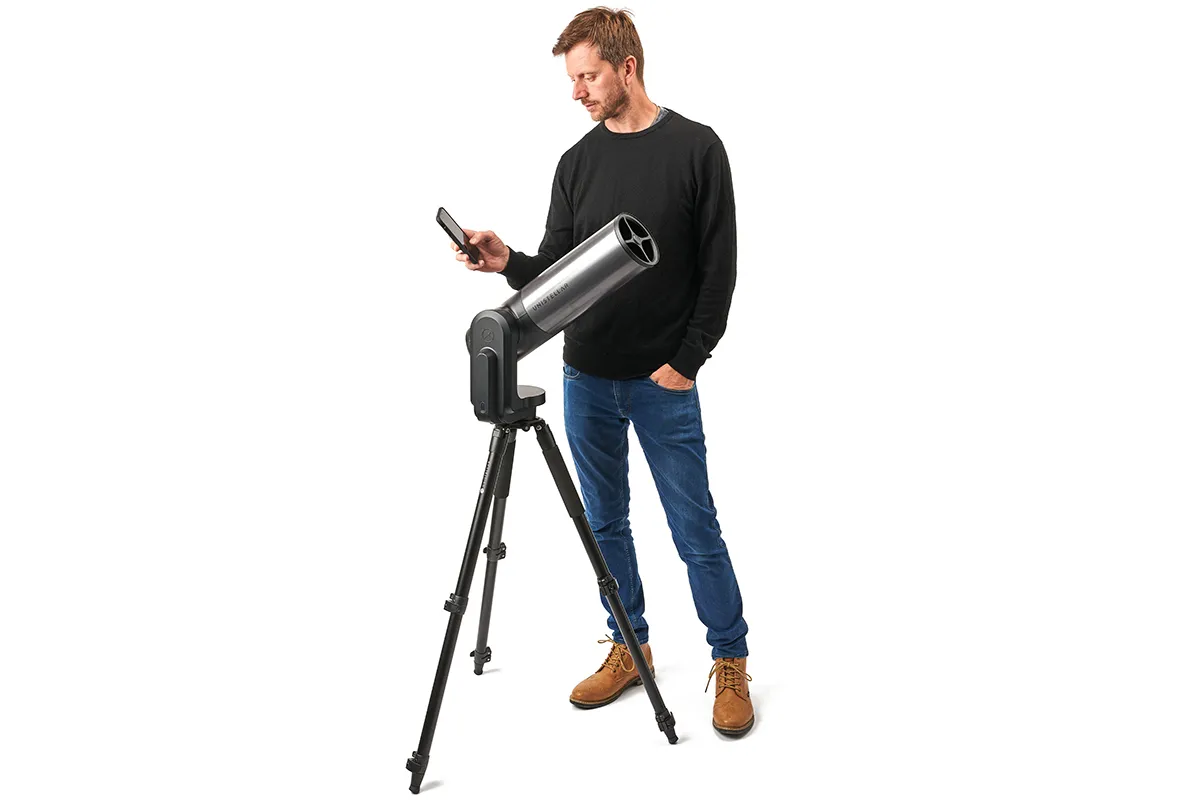
At its core, the Unistella eVsccope eQuinox is a cool piece of kit that effortlessly produces images of the night sky and sends them to your smartphone or tablet.
If you're not interested in learning the fundamentals of observing with a telescope or fiddling with camera settings, but simply want a great piece of technology that will give you beautiful captures of deep-sky objects, this could be the telescope for you, provided the price tag doesn't put you off.
The eVscope eQuinox is a 4.5-inch, f/4 reflector with a camera sensor that tracks and stacks images in real-time to produce the final image.
Yes, it will even do image processing for you.
Everything is done via the app, so you will need a tablet or smartphone. Up to 10 devices can be linked to the telescope over Wi-Fi, making it a good option for astronomy outreach or star parties.
The app asks whether you're in a city, suburb or countryside, then recommends targets suited to your surroundings.
The Ring Nebula looked bright and colourful after just 24 seconds. The Andromeda Galaxy was similarly inspiring.
The images produced by the eQuinox do ultimately fall short of those produced by astrophotographers using cameras on dedicated telescopes, but if you're interested in this sort of telescope, the ease and gadgetry involved will more than likely make up for it.
Key specs
- Optics 114mm (4.5-inch) reflector
- Focal length 450mm, f/4
- Sensor Sony Exmor IMX224
- Mount Motorised single-arm, altaz, Go-To
- Power In-built lithium-ion rechargeable (12-hour) battery
- Tripod Aluminium, adjustable height
- Ports USB-C for power, and USB-A for charging a smartphone
- App control Unistellar app for smartphones
- Weight 9kg
Read our full Unistellar eVscope eQuinox review.
Founder Optics FOT106 triplet refractor
- Buy now from Widescreen Centre

The FOT106 has an f/6 106mm objective lens with a focal length of 636mm, putting it in the realms of being able to image larger star clusters, galaxies and nebulae.
The balance point of the tube is fairly central, which makes it easy to mount for astrophotography.
During our imaging session we attached a field-flattener to our DSLR camera T-Ring via the M48 adaptor option provided.
We photographed star-rich areas and found central stars were round and pin-sharp.
We reckon a crop area of about 70% of full-frame size would produce acceptable star shapes, making it about right for DSLR and CMOS cameras with APS-C-size sensors or smaller.
Key specs
- Optics Air-spaced apo triplet
- Aperture 106mm
- Focal length 636mm
- Focuser Rack and pinion
- Extras Field-flattener, carry handle, lens cloth, Inspection Report and owner’s manual
- Weight 6.7kg (with tube rings; 5.5kg without)
Read our full Founder Optics FOT106 triplet refractor review.
Celestron 11-inch Rowe-Ackermann Schmidt astrograph
- Buy now from B&H

Celestron’s Rowe-Ackermann Schmidt astrograph is made specifically with the sole purpose of imaging the night sky, so if this is your number one aim, you're in good hands.
Dividing its 620mm focal length by its 279mm (11-inch) aperture shows it to be a fast f/2.22 telescope.
The best camera to use with the RASA would be a CCD camera with a low circular profile, so it's hidden behind the adaptor plate. But DSLRs can be used too.
During our imaging session we were able to go deep very quickly.
Within 5 seconds at ISO 1600 we captured a huge amount of detail in and around the Orion Nebula.
This is another large, hefty telescope at a costly price, but is certainly a good option for those who are serious about astrophotography.
Read our full Celestron 11-inch Rowe-Ackermann Schmidt astrograph review.
Key specs
- Aperture: 279mm (11 inches)
- Focal Length: 620mm (f/2.22)
- Weight: 19.5kg
Altair Starwave 70 EDQ-R quad apo imaging refractor
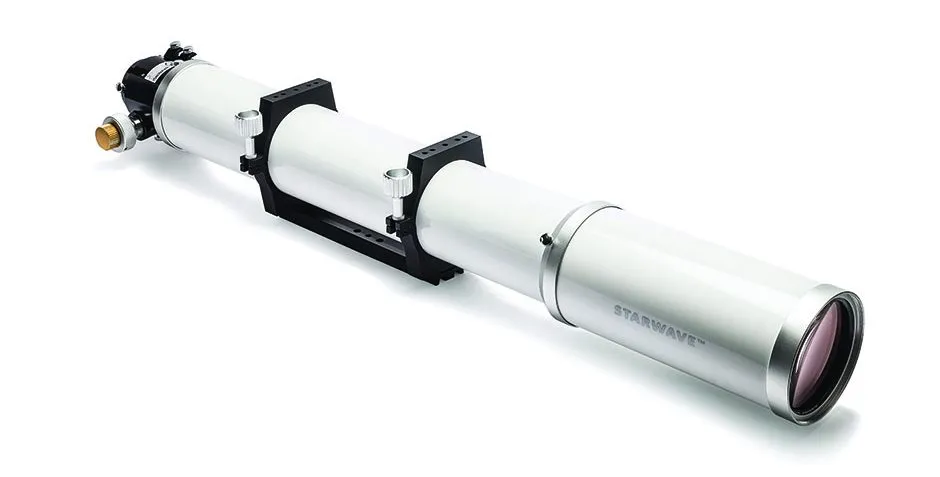
The Starwave 70 EDQ-R has a 350mm, f/5 focal length and is aimed at wide-field imaging.
Indeed, given the right camera it is able to fit some really big objects into its field of view.
What's more, this telescope is very user-friendly. Much of this is down to just how light it is: even with a Canon DSLR attached it weighed around 2kg, making it a good grab-and-go scope.
We imaged the Andromeda Galaxy with a finder-guider configuration on a portable tracking mount.
3x20-minute images revealed lots of detail in the dust lanes and round, colourful stars. We were very happy with the result.
Key specs
- Aperture: 70mm
- FocalLength: 350mm, f/5
- Weight: 1.4kg
Read our full Altair Starwave 70 EDQ-R quad apo imaging refractor review.
Stellina Observation Station
- Buy now from Adorama
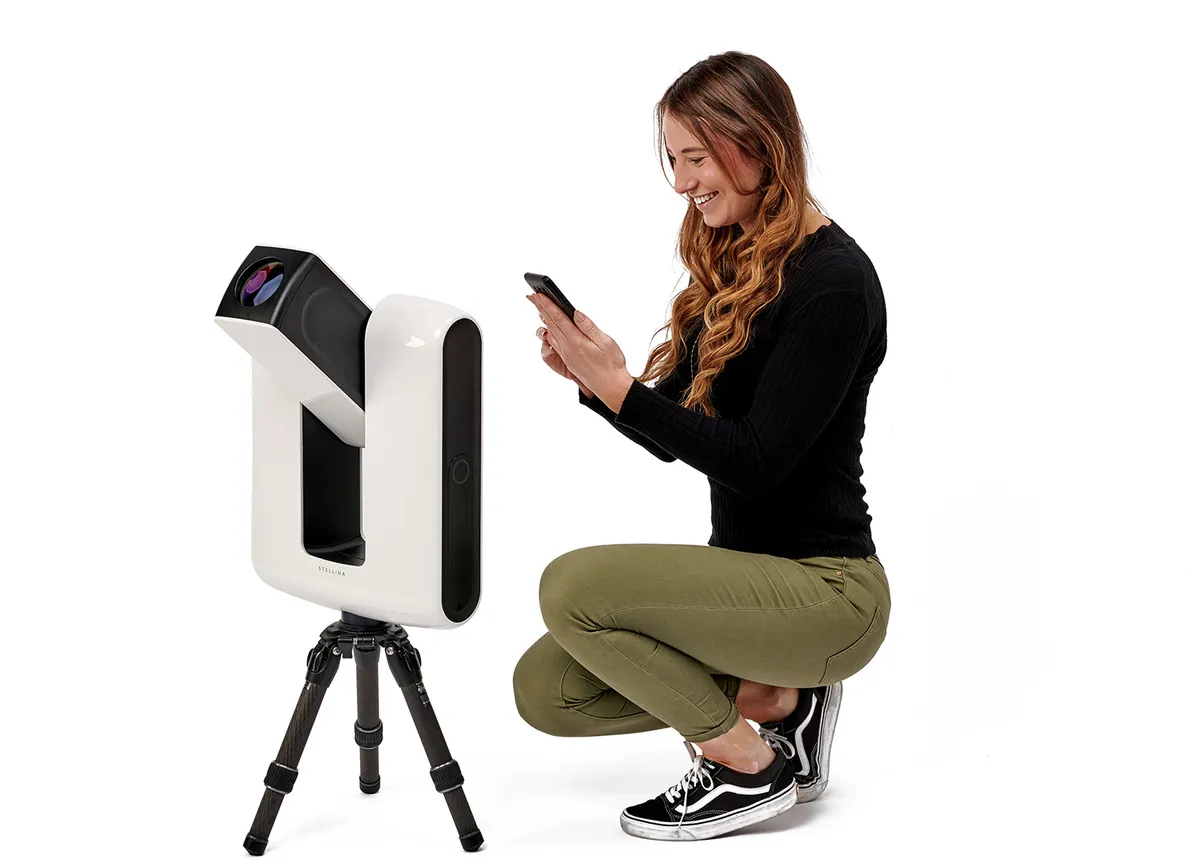
The Stellina is another cool piece of kit that offers to take all the manual tinkering out of astrophotography, automatically capturing images of deep-sky targets without the need for guiders, mounts, computer software, or even an external camera.
Assembly is easy and we were able to capture a range of targets including the Orion Nebula, the Cigar Galaxy, the Crab Nebula and the Andromeda Galaxy.
Again, like the eVscope, this is an all-in-one device that takes the hassle out of imaging the night sky, but it also removes the element of control.
If you want to be able to manually control every aspect of your astro imaging session, it's not for you.
But if you want a nifty piece of tech that will do everything for you and leave you with beautiful images, this could be the one to go for.
Key specs
- Optics 80mm ED doublet refractor
- Focal length 400mm (f/5)
- Mount computerised robotic altazimuth
- Ports 1 USB type-C (power), 2 USB type-A (image storage; not included)
- App control Stellina app; targets include galaxies, nebulae, clusters and the Moon
- Sensor Sony CMOS IMX178,
- Extras Integrated dew heater and de-rotator, fabric shroud, bubble level, Gitzo Systematic tripod, 10,000 mAh battery, cables
- Weight 11.2kg
Read our full Stellina Observation Station telescope review.
Unistellar eVscope eQuinox 2
- Buy now from Park Cameras
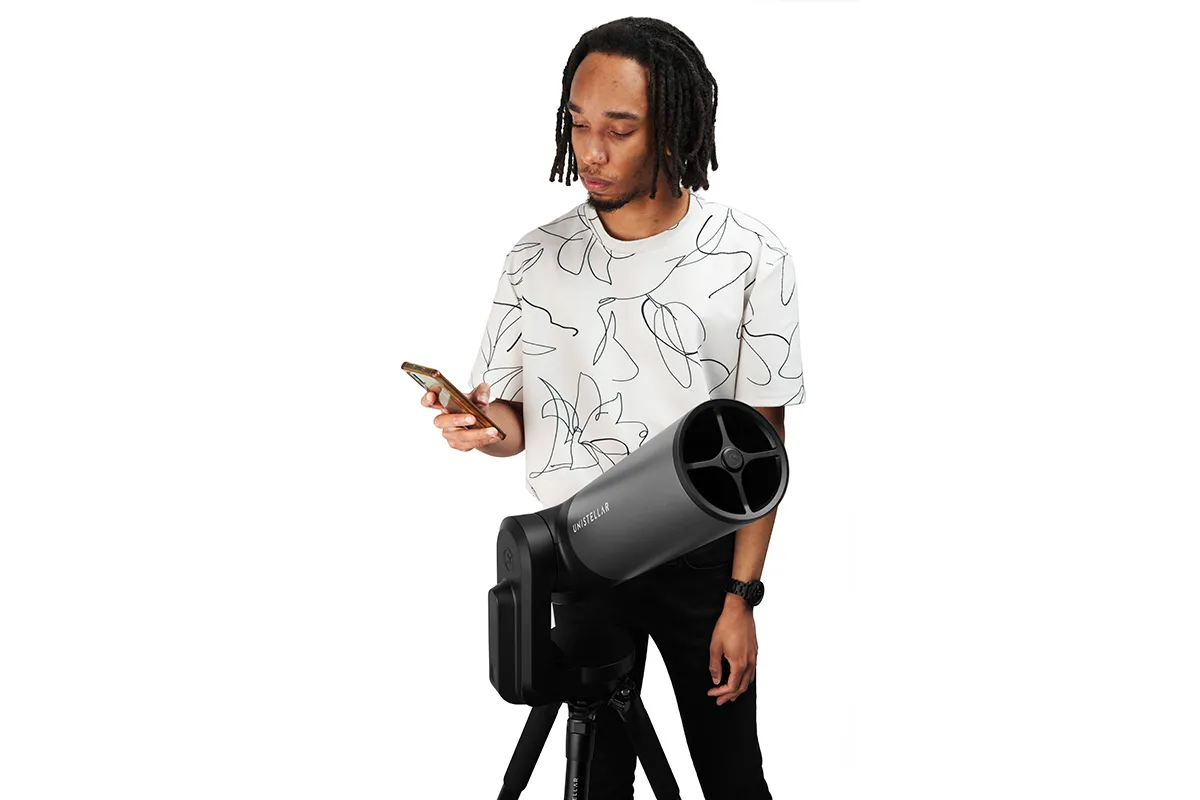
Unistellar's eQuinox 2 is a 4.5-inch (114mm) reflector mounted on a motorised altazimuth mount.
It is a truly automated telescope, operated via an app that enables the telescope to autonomously align with and track the night sky.
Inside is a Sony IMX347 image sensor, used to capture short exposures of deep-sky objects like galaxies and nebulae.
The telescope's internal computer then stacks the images in real time, revealing a clearer and clearer image that appears before your very eyes on the screen.
You can then share these images on social media.
Key specs
- Optics: 114mm (4.5-inch) reflector
- Focal length: 450mm, f/4
- Sensor: Sony Exmor IMX347
- Mount: Motorised single-arm, altaz, Go-To
- Power: In-built lithium-ion rechargeable battery
- Tripod: Aluminium, adjustable height
- Ports: USB-C for power; USB-A for charging
- App control: Unistellar (Android and iOS)
- Weight: 9kg
Read our full eVscope eQuinox 2 review
William Optics Zenithstar 126 apo refractor
- Buy now from First Light Optics
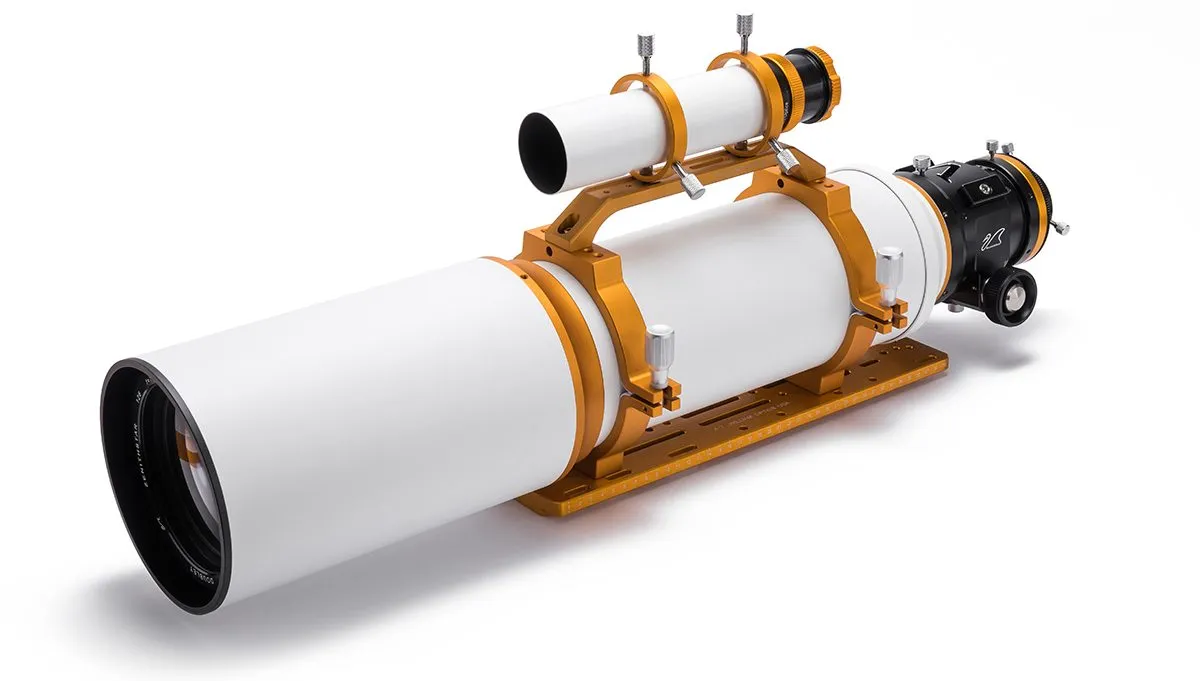
A lightweight, portable scope, the ZS61-II boasts a 61mm objective lens with a focal length of 360mm, giving it a mid-range focal ratio of f/5.9.
The scope can be used for capturing images of the Moon and planets and - with the correct solar filter attached - the Sun.
During our imaging sessions, the Bahtinov mask provided in the dew shield really helped with reaching accurate focus.
This is also a result of the ZS61-II’s dual-speed rack and pinion focuser, which is positive and responsive.
Overall, this is great visual telescope but can also be used for imaging, while its portability makes it a good option for travelling to dark-sky sites.
Key specs
- Optics f/7.7 apochromatic FPL53 doublet
- Aperture 126mm
- Focal length 970mm
- Focuser 3-inch V-Power dual speed Crayford
- Extras Dovetail bar, tube rings, carry handle, Bahtinov mask
- Weight 9.94kg
Read our full William Optics Zenithstar 61 II APO review.
Omegon Telescope Pro RC 203/1624 review
- Buy now from eBay
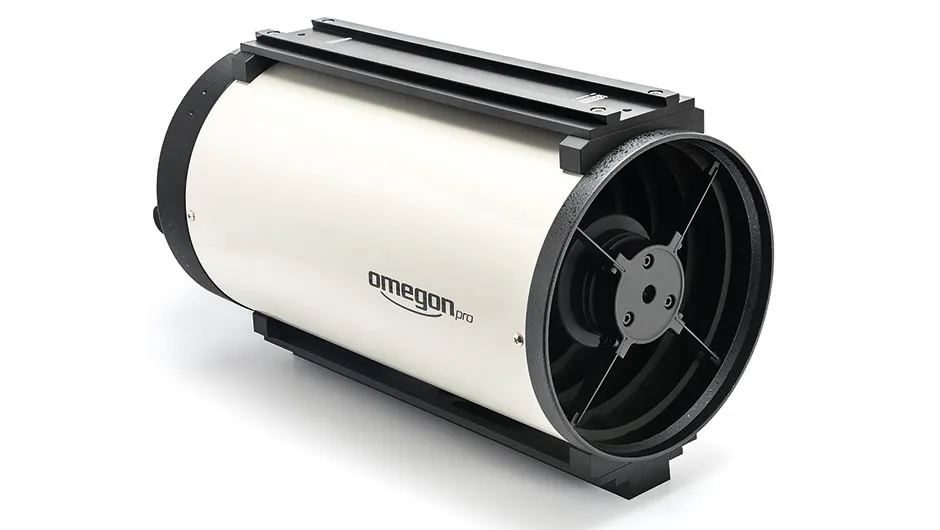
The Omegon Telescope Pro RC 203/1624 is aimed at experienced astrophotographers.
We began our imaging session with the Hercules Globular Cluster, taking a series of 5- and 10-minute exposures that revealed sharp details and colour at the core, continuing to the outer edges as well.
The Dumbbell Nebula and the Whirlpool Galaxy were similarly impressive.
When our 15-minute exposure of the Whale Galaxy appeared on the screen it was a real 'wow!' moment.
We found a bright galactic core and beautifully defined dark dust lanes, all captured with crisp sharpness.
Key specs
- Aperture: 203mm
- FocalLength: 1,624
- Weight: 6.2kg
Read our full Omegon Telescope Pro RC 203/1624 review.
TS 65mm f/6.5 Quadruplet Astrograph
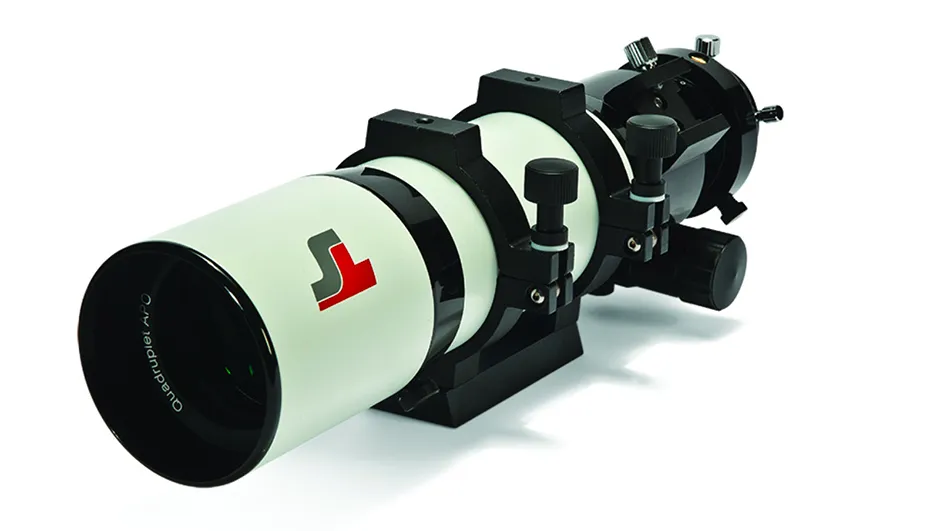
The Teleskop-Service 65mm Quadruplet Astrograph has 2-inch rack-and-pinion focuser that's well-made and securely held our camera and astro imaging kit with no slippage, even with the tube pointing up towards the zenith.
The multicoated 65mm aperture, f/6.5 triplet lens has a focal length of just 420mm. This makes for a 3° by 2° field with the typical APS-C size sensor found in DSLR cameras.
This field of view would hold Orion’s ‘belt’ stars. During our star test we captured Vega and were really impressed.
It showed excellent star shapes at the centre and into the corners of our CCD camera's field of view.
We then turned to the Milky Way and captured the nebulosity around the star Sadr in Cygnus. We were very impressed with this telescope.
Key specs
- Aperture: 65mm
- Focal Length: 420mm; f/6.5
- Weight: 2.8kg including tube rings
Read our full TS 65mm f/6.5 Quadruplet Astrograph review.
Altair 8-inch F4 Photo Newtonian Telescope
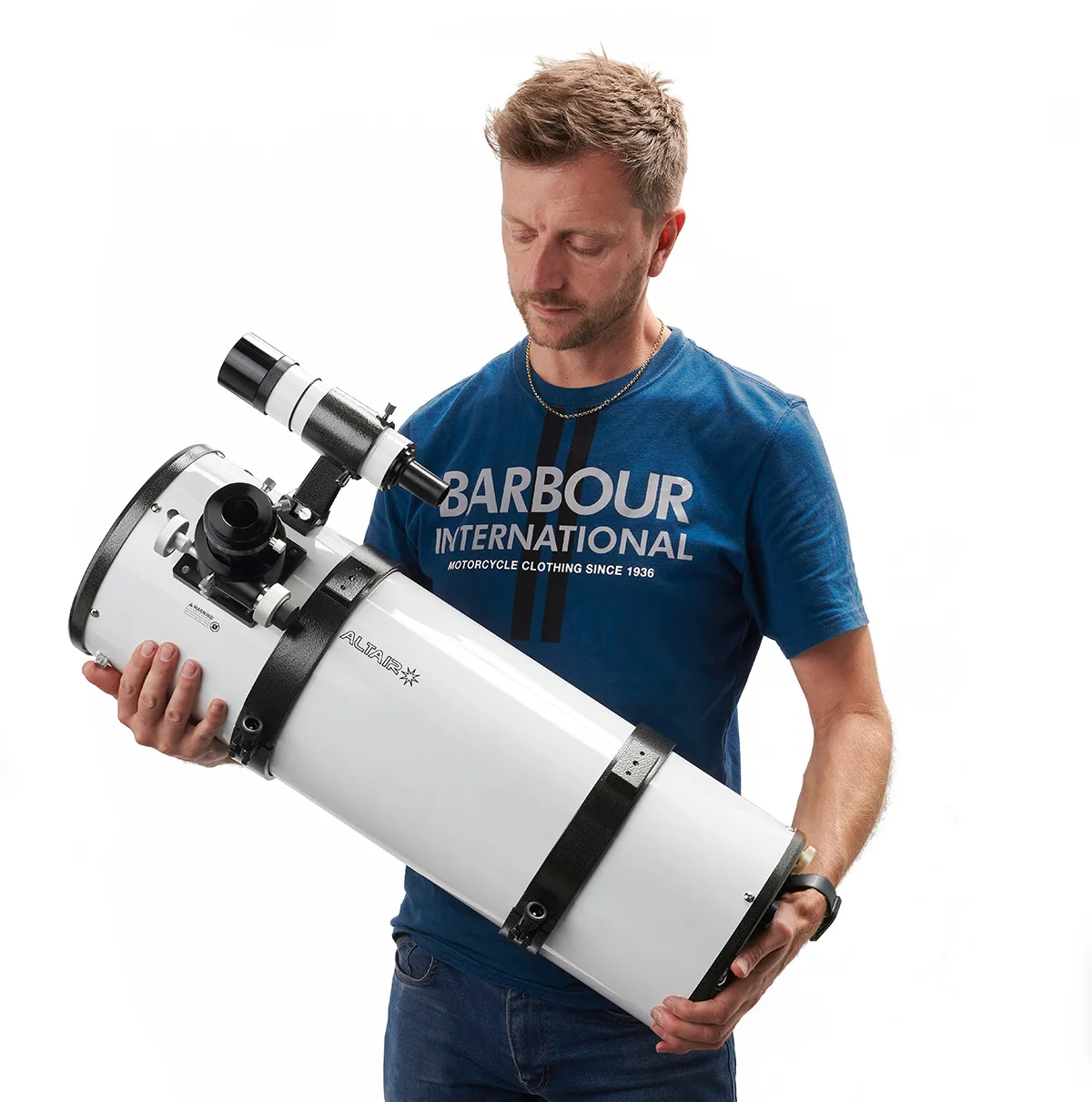
This reflecting telescope from Altair is designed to be used for astrophotography.
It's a sturdy steel tube with rings and fittings and weighs about 8.4kg even without astro imaging equipment attached. As a result, you'll need a very strong, good mount to make the most of its light-gathering power.
We imaged the Dumbbell Nebula, using the surrounding star field to check star shapes, which looked good right into the corners of the view.
We proceeded with short 5-minute exposures and were reminded why fast Newtonian imaging astrographs are so attractive to astrophotographers.
Key specs
- Optics: BK7 glass mirror
- Aperture: 203mm (8-inch)
- Focal length: 800mm
- Focuser: 2-inch Crayford with 1:10 dual speed transmission
- Extras: Finderscope, 35mm extension tube
- Weight: 8.4kg
Read our full Altair 8-inch F4 Photo Newtonian Telescope review.
Celestron Inspire 100AZ refractor
- Buy now from PicStop

Experienced astrophotographers might frown at our inclusion of the Celestron Inspire 100AZ in this list of best telescopes for astrophotography, but for complete beginners who want a good value scope that will let them capture images on their smartphone, this is a great choice.
It's worth remembering that the Inspire 100AZ's non-motorised mount is not designed with astrophotography in mind, but the telescope's dust cap enables a smartphone to be attached that can then be paired with one of the included eyepieces for a spot of afocal photography.
We were able to capture a video of the Moon through the 20mm eyepiece, which we then stacked into a single image.
You could do the same with the Sun, provided you used a suitable front-mounted solar filter.
If you're a beginner looking to buy your first telescope and you'd like to have a go at smartphone astrophotography, this might be the model for you.
Key specs
- Optics Achromatic lens
- Aperture 100mm (4 inches)
- Focal Length 660mm, (f/6.5)
- Focuser Single-speed rack and pinion with micrometer scale
- Mount Manual Altazimuth
- Extras Red-dot finder, erect image star diagonal, 10mm and 20mm eyepieces, red light LED torch, printed instruction manual
- Weight 6.1kg
Read our full Celestron Inspire 100AZ refractor review.
Sky-Watcher Evostar 72 refractor
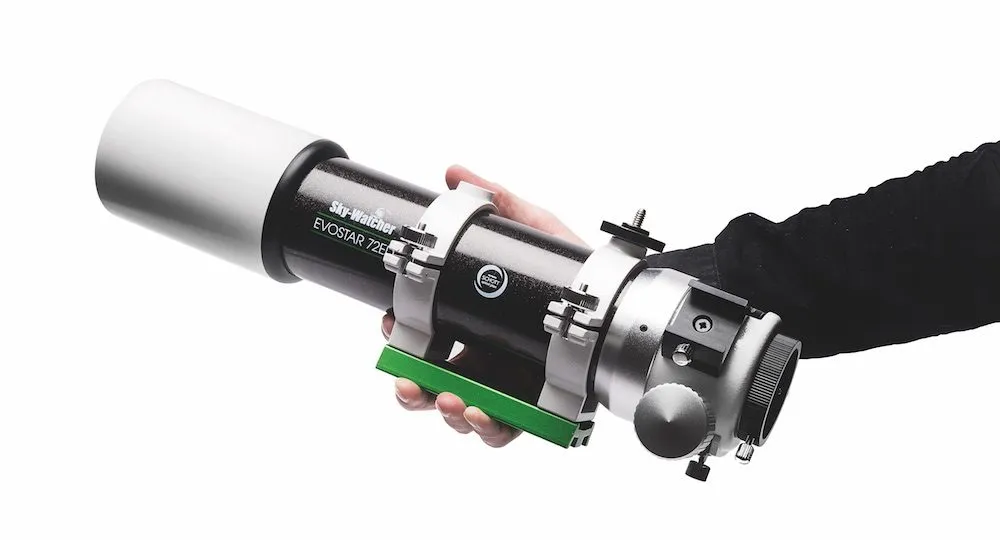
This is another great budget telescope that won't break the bank but will provide great visual observing as well as imaging capabilities.
What's more, it's nice and compact, making it another good option for those who want a reliable imaging telescope to take to dark-sky sites.
We used our Star Adventurer tracking mount to capture M44 with 13x30-second exposures, and the results were satisfying.
Then we used our AZ-EQ6 mount to photograph M81 and 82 using 12x120-second exposures. We achieved great detail in our images and were thoroughly pleased with the results.
The Evostar 72ED DS-Pro is a satisfying, lightweight scope great for observing the night sky as well as for astrophotography.
Key specs
- Aperture 3-inch (72mm)
- Focal Length 422mm, f/5.8
- Weight 1,955g
Read our full Sky-Watcher Evostar 72ED DS-Pro refractor telescope review.
Vixen R200SS Newtonian reflector
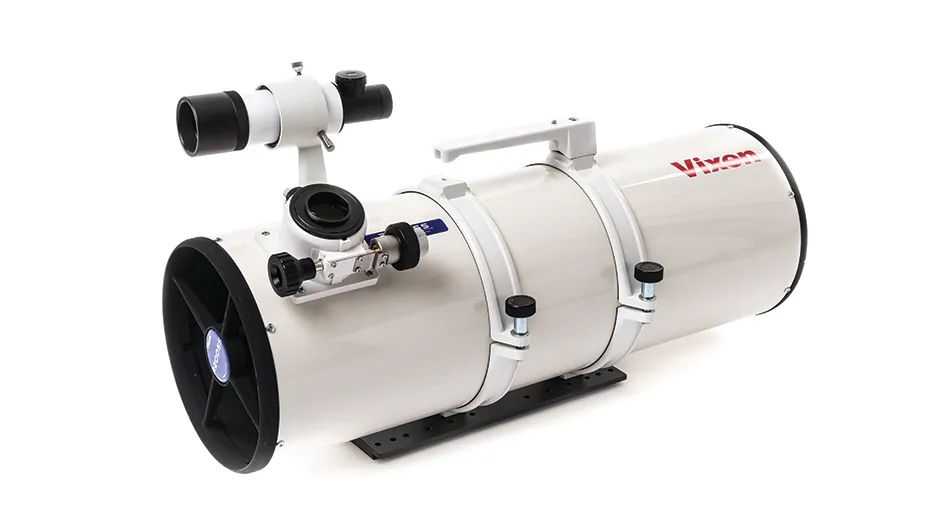
Those reading this article in the UK will be all too aware of how unpredictable and temperamental the weather can be.
This makes a fast scope with good aperture that's easy to set up very appealing, and the Vixen R200SS certainly fits into this bracket.
We tested the telescope out with a DSLR camera and Bahtinov mask and we found the focus was crisp across the entire field of view.
The corrector keeps good colour across the red, green and blue wavelengths, so if you're imaging with a DSLR or CCD camera, you won't be plagued by bloated blue stars.
We found the images produced from the R200SS and Corrector PH in combination were brilliant, and enjoyed seeing sharp, well-shaped stars even at the edges of the frame.
Key specs
- Aperture: 200mm (8 inches)
- Focal Length: 760mm (f/3.8)
- Weight: 5.3kg
Read our full Vixen R200SS Newtonian reflector plus Corrector PH review.
Meade LX600-ACF 12-inch Schmidt-Cassegrain
- Buy now from Orion Telescopes
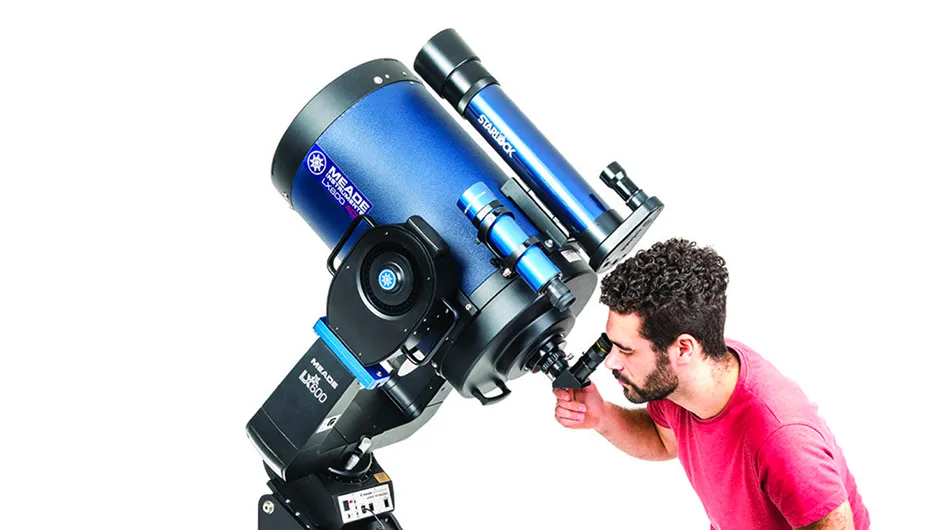
The included sturdy field tripod and optional Meade X-Wedge make this a solid, sturdy platform suitable for long-exposure imaging.
We liked the StarLock feature, which gives the astrophotographer precision pointing accuracy as well as autoguiding functionality.
The LX600 really shines when used for planetary imaging, as the StarLock helps keep the target in the middle of the field of view.
Indeed, this is a scope that particularly suits those who like producing planetary time-lapses.
The generous 2.4m focal length offers good image scale without an optical amplifier.
In summary, this is a formidable astro-imaging platform.
Key specs
- Aperture: 305mm (12 inches)
- Focal Length: 2438mm, f8
- Mount: Giant Field Tripod
- Weight: Telescope tube 16.3kg, drive base with fork arms 22.7kg, tripod 22.7kg
Read our full Meade LX600-ACF 12-inch Schmidt-Cassegrain review.
RVO Horizon 60ED Doublet refractor
- Buy now from Rother Valley Optics
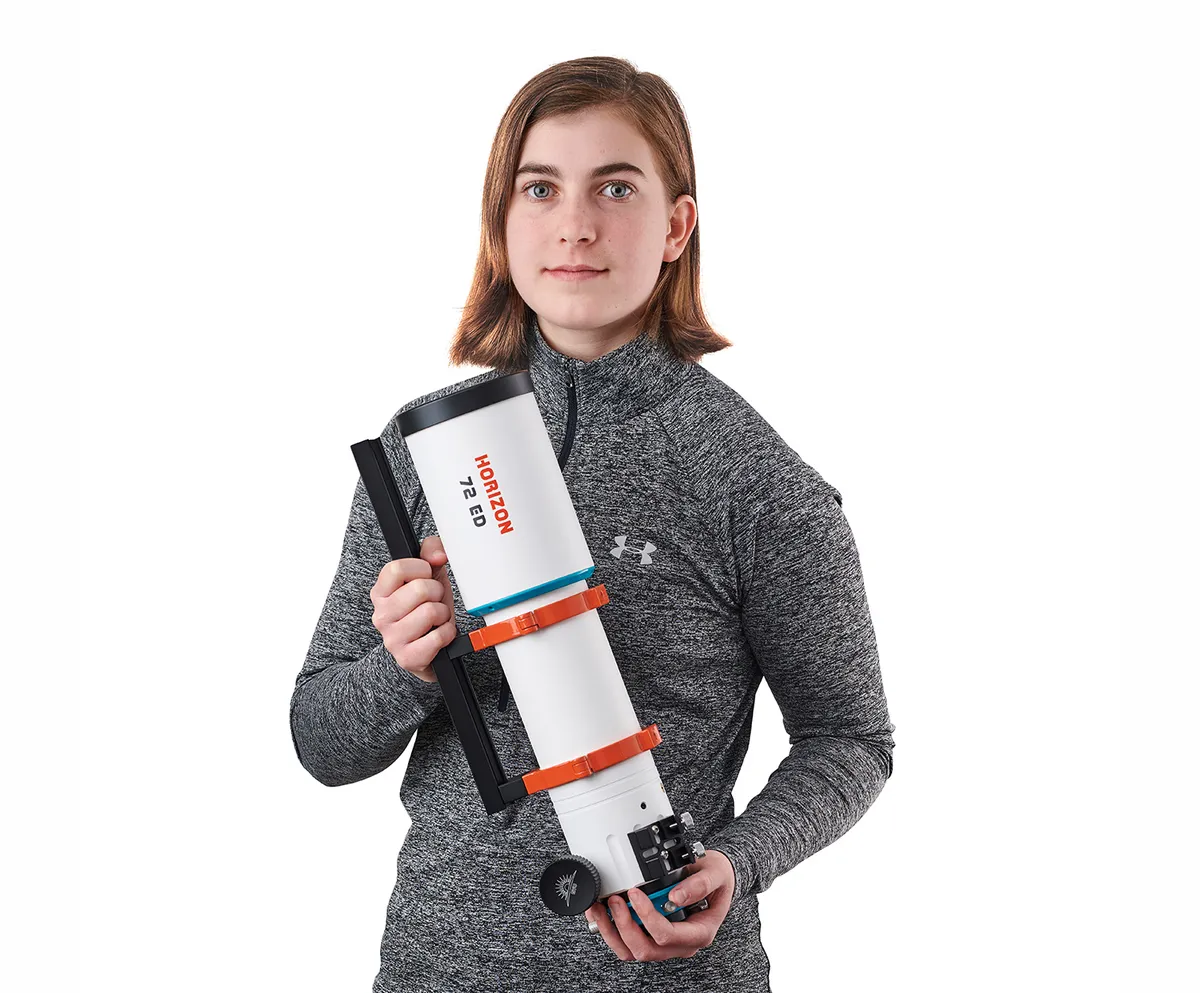
A key aspect of the Horizon 60ED is its portability. The telescope is supplied in a sturdy case that houses the entire assembly, so the only extras you need for an imaging session in a dark-sky site are a DSLR and a good mount.
The whole setup including DSLR weighs less than 3kg, so could easily be supported by most star-tracking mounts.
We captured images of Orion and found them to be remarkably good, particularly given our full-frame camera.
The Horizon 60ED refractor is a good value, capable astrophotography telescope with the added bonus of coming in a portable package,
Key specs
- Optics FPL-53 Doublet
- Aperture 60mm
- Focal length 360mm, f/6
- Focuser 2-inch rack and pinion with camera angle adjuster
- Extras Dovetail bars, tube clamp, guidescope
- Weight 1.78kg
Read our full RVO Horizon 60ED Doublet refractor review.
William Optics GTF 102 astrograph

We used a CCD camera with an APS-C sensor to test the WO GTF 102, so the star shapes in our images are a good sign as to what you might expect to achieve with a typical DSLR camera, which has a similarly sized sensor.
The shape of stars across the field of view were beautiful, even right into the corners. Clearly the two-element internal field flattener was doing its job.
The same can be said for the triplet lens, as chromatic aberration was also well controlled.
Multi-element designs like this can sometimes cause focus shift as the temperature changes.
But we didn't need to adjust focus during a 4.5-hour astrophotography run, despite the presence of a thick frost on the inside of our domed garden observatory.
We would recommend the WO GTF 102 to any astro imager who wants a well-performing instrument that removes the hassle of achieving a flat field with stars pin sharp to the edge.
Key specs
- Aperture 102mm (4 inches)
- FocalLength 703mm, f6.9
- Weight 5kg excluding tube rings
Read our full William Optics GTF 102 astrograph review.
Celestron RASA-8 telescope
- Buy now from B&H

Like other astrographs on our list, the Rowe -Ackermann Schmidt Astrograph is primarily designed for astrophotography.
The RASA-8 has an effective focal length of 400mm and an aperture of 203mm, so its focal ratio is f/2.
In astrophotography terms, f/2 is fast, indicating it can capture deep-sky images very quickly.
We found we could reach serious depth with short exposures: our Atik 314L cooled CCD camera was able to reach mag. 15 in one second.
And under challenging skies we were able to capture mag. 17.5 galaxies with 30-second exposures.
A 30 second image of the Leo Triplet, for example, recorded great detail in each galaxy.
This is a great grab-and-go instrument for deep-sky astrophotography.
Key specs
- Optics Rowe Ackermann Schmidt
- Aperture 8-inch (203mm)
- Focal length 400mm (f/2)
- Focuser Ultra stable focusing system
- Extras M42 camera adaptor, C-thread camera adaptor, fan battery pack
- Weight 7.7kg (17lbs)
- Dimensions 628x235mm
Read our full Celestron RASA-8 telescope review.
Explore Scientific PN210 Carbon Mk II Imaging Newtonian review
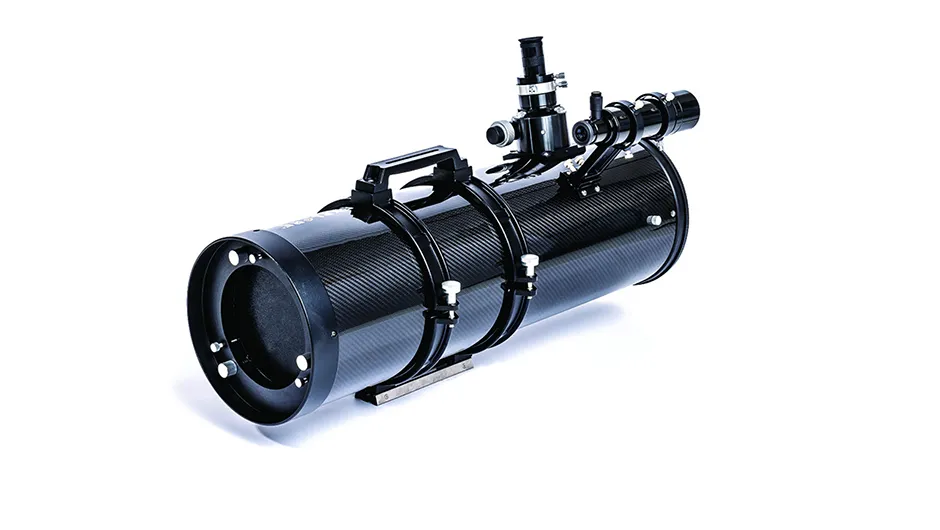
The PN210 Mk II is a grab-and-go telescope with great portability. Its fast f/3.8 optics enable you to capture real depth with short exposures.
This is due to the 210mm parabolic primary mirror at the heart of the telescope.
The PN210 Mk II is easy to transport to a dark-sky location, meaning you can take advantage of those optimum conditions to capture some great deep-sky images.
The 800mm focal length of the primary mirror delivers a fairly wide field of view at prime focus.
We used a Canon EOS 6D full frame DSLR camera and were able to cover a sky area of 2.5x1.5° with our images.
However, we would recommend using a field flattener. Being a Newtonian reflector, the PN210’s field does suffer from coma.
Despite this, this is a great telescope that will perform well for deep-sky imagers.
Key specs
- Price: £849.00
- Focal Length: 800mm (f/3.8)
- Weight: 6.75kg
Read our full Explore Scientific PN210 Carbon Mk II Imaging Newtonian review.
StellaMira 90mm ED triplet apochromatic refractor
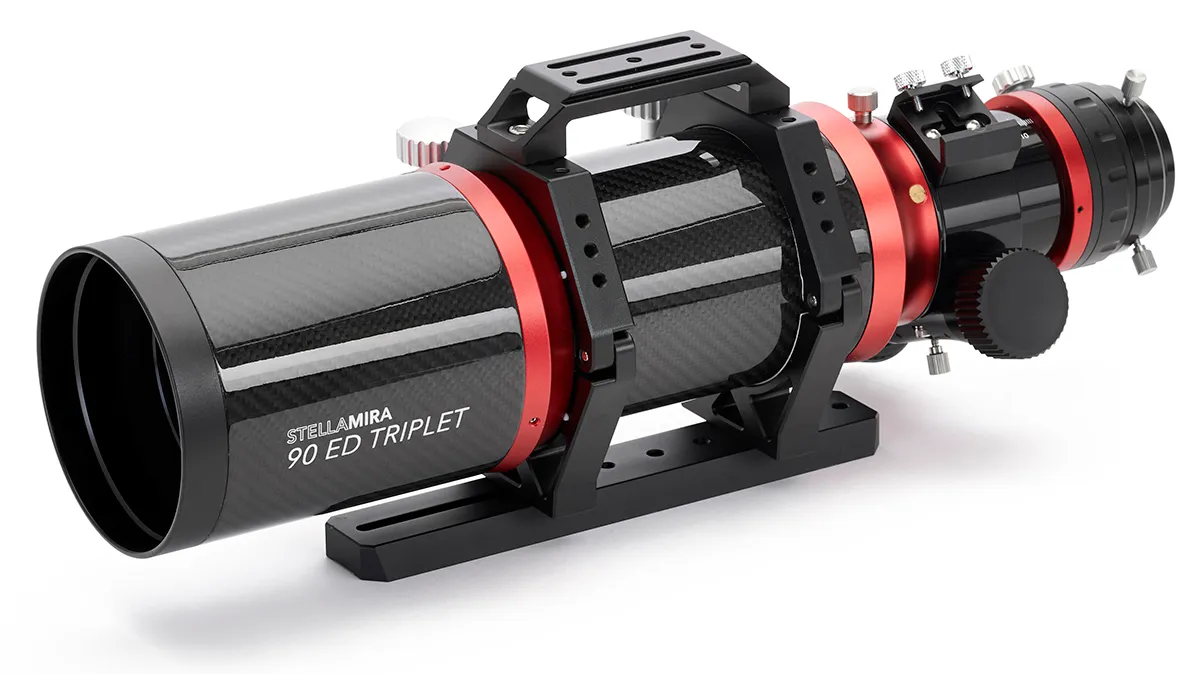
The 90mm lens of the StellaMira 90 offers a 540mm focal length, which gives it a fast f/6, making it suited to astrophotography.
We used a CCD camera and DSLR to test out the telescope, and found round and sharp stars.
We particularly liked the focuser arrangement: the whole focuser body rotates, allowing control knobs to be conveniently placed while a separate camera rotator allows adjustment of the camera angle.
We found the hot blue stars of the Pleiades and the tight star grouping of the Trapezium Cluster to be beautifully crisp and free of unwanted artefacts.
The StellaMira 90mm ED produces excellent astro imaging results.
Key specs
- Optics: f/6 apochromatic triplet
- Aperture: 90mm
- Focal length: 540mm
- Focuser: 2.5-inch rack and pinion
- Extras: Tube rings and a carry case
- OTA weight: 3.3kg
Read our full StellaMira 90mm ED review.
WideSky 80 refractor
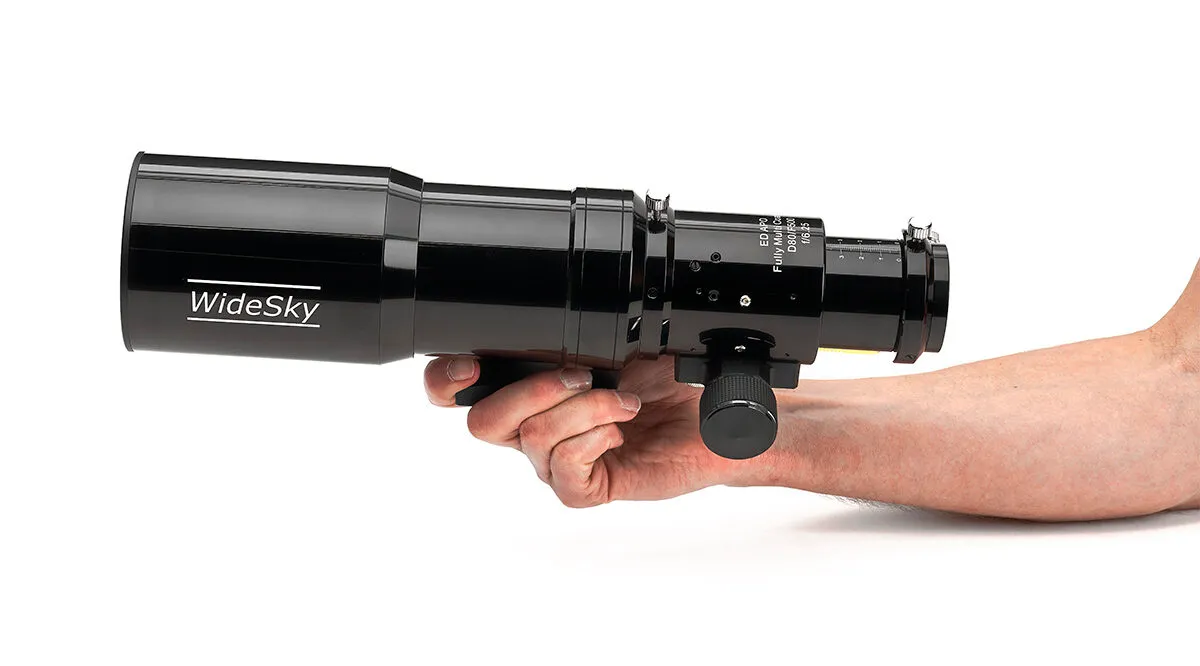
The WideSky's 80mm glass is an ideal aperture for a first astrograph, making it suitable for capturing images of nebulae, galaxies and star clusters.
The telescope captures enough light for imaging many popular deep-sky objects and it also gives a lovely field of view for lunar photography.
Paired with a cropped-sensor DSLR, a full-frame DSLR, or a designated astro camera, the WideSky 80 can handle a wealth of configurations and is a good option for beginner astrophotographers who want to develop their skills and invest in camera kit without wanting to upgrade their telescope.
Key specs
- Optics: ED doublet with fully multi-coated Ohara FPL-53 glass
- Aperture: 80mm
- Focal length: 500mm, f/6.25
- Focuser: Heavy duty dual-speed 2-inch rack and pinion hybrid drive with 10/1 (ratio from coarse to fine) and brass compression ring
- Extras: Retractable dew shield, 2- to 1.25-inch adaptor, aluminium case, Vixen-style dovetail-profile mounting foot
- Weight: 2.9kg
Read our full WideSky 80 refractor review.
iOptron Photron RC6
- Buy now from B&H Photo Video
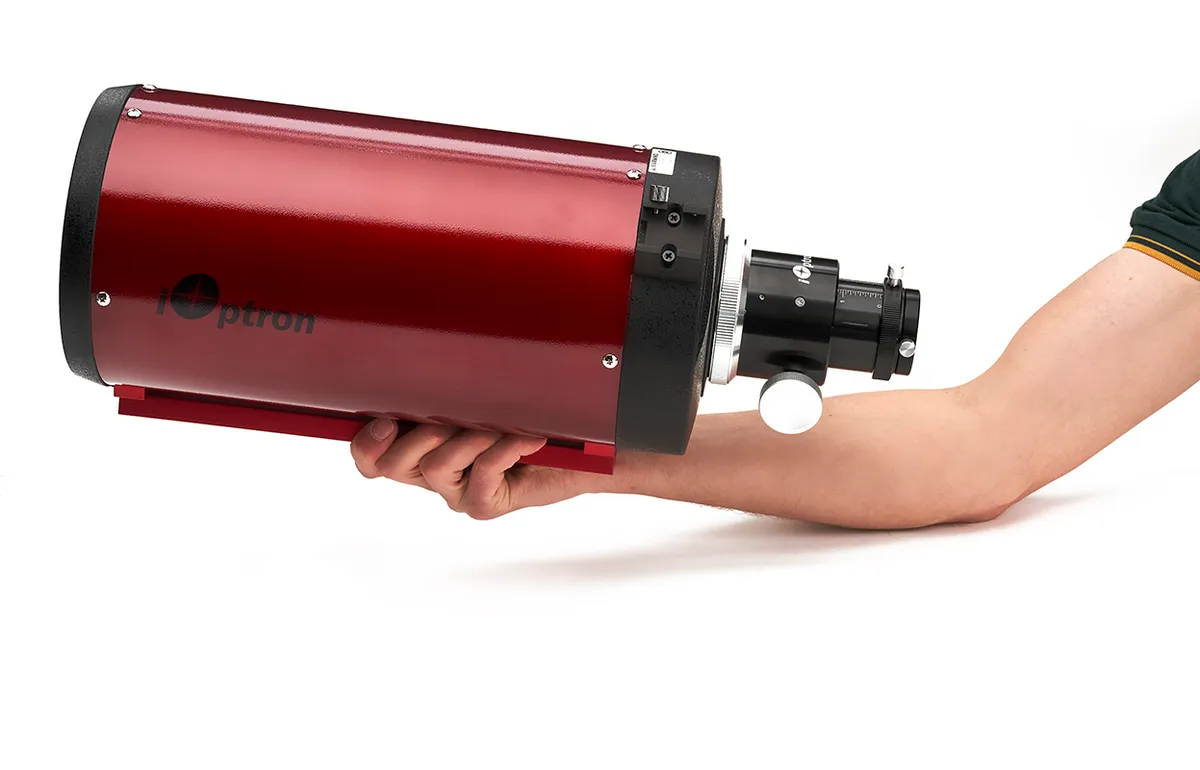
The Photron RC6 Ritchey-Chrétien is a great telescope and can be used for both observing and imaging.
The Photron RC6 offers a focal length of 1,370mm, making it suited to picking up smaller deep-sky targets like galaxies, planetary nebulae and globular clusters.
We found our images of the Trapezium Cluster were great, with satisfying round stars and good sharp edges on the nebulosity.
We turn to globular clusters M3 and M13 and also imaged Bode's Galaxy and the Cigar Galaxy.
We also reckon the Photron RC6 would be perfect for imaging Messier Catalogue objects, since as it works well with a colour camera and can be easily transported to dark sky sites.
Key specs
- Optics: Ritchey-Chrétien Cassegrain
- Aperture: 150mm (6-inch)
- Focal length: 1,370mm, f/9
- Focuser: 2-inch dual-speed Crayford
- Length: 490mm
- Weight: 5.4kg
Read our full iOptron Photron RC6 6-review.
Sky-Watcher Quattro 150P f/4 astrograph review

We attached our CCD camera to the Quattro's corrector and found the 150P really performed well.
Focusing was easy and accurate, producing acceptable star shapes in the corners of our 16mm sensor images
The Quattro also has thin spider vanes that produce sharp diffraction spikes, so a target like the Pleiades cluster, was ideal. We were able to captured a good deal of nebulosity with 3-min exposures.
We also imaged the Andromeda Galaxy and Triangulum Galaxy and found that the wide view on offer was great.
Indeed, for such a capable telescope, the price point makes this a real bargain.
Key specs
- Optics: Newtonian reflector, 0.86x aplanatic coma corrector
- Aperture: 150mm
- Focal length: 600mm, f/4; 515mm with coma corrector
- Focuser: 2-inch Linear Power Crayford-style focuser
- Extras: Dovetail bar, tube rings, 6mm x 30mm finder scope
- Weight: 5.7kg
Read our full Sky-Watcher Quattro 150P f/4 astrograph review
Sharpstar Z4 sextuplet apo astrograph review
- Buy now from Ali Express
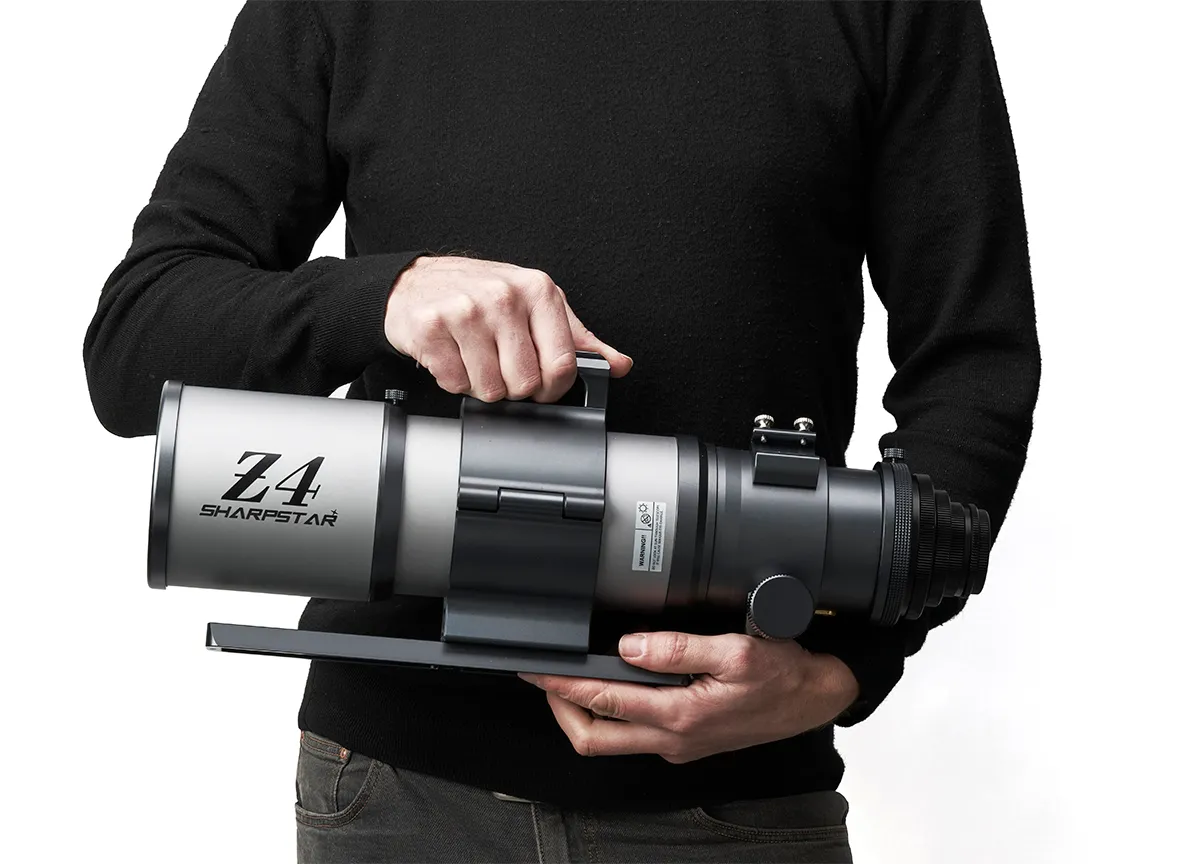
The Sharpstar Z4 packs a significant punch with a six-element optical system, making for a fabulous telescope for capturing images of the night sky.
During testing, the weather was unpredictable, so we focussed on what we could captured via short exposures.
We slewed to the Sadr region in Cygnus. Initial test frames confirmed a flat field of view with no observable star curvature or halos.
We captured an hour’s worth of frames on the Butterfly Nebula (IC 1318) then hopped over to the Tadpoles (IC 410), the Red Spider (NGC 6537) and the Fly (NGC 1931) nebulae.
Despite the short exposure times, our images looked great, with no bloated stars or uneven background gradients.
Price-wise, however, the Sharpstar Z4 is probably more for experienced astro imagers than beginners, but it is certainly user-friendly.
Key specs
- Optics: Air-spaced apo sextuplet
- Aperture: 100mm
- Focal length: 550mm, f/5.5
- Focuser: 3.4-inch dual-speed rack and pinion; 1:10 ratio fine adjustment knob
- Extras: Dovetail bar, tube rings, adaptors, carry case, handle, retractable dew shield
- Weight: 4.3kg
Read our full Sharpstar Z4 sextuplet apo astrograph review.
William Optics Gran Turismo GT81 refractor

At 478mm focal length (f/5.9), the GT81 is a good option for imaging mid to large nebulae.
And that's even when the telescope is paired with smaller imaging sensors like our one-third-size CCD.
However, the telescope's short focal length doesn’t limit the astro imager to just nebulae.
Thanks to the FPL53 glass, the GT81 has a 95+ Strehl ratio, giving pinpoint stars and sharp detail.
Fine details can be resolved in globular clusters and dusty regions of galaxies.
This is a telescope designed for large and heavy cameras, and it doesn't disappoint.
Key specs
- Optics: Air-spaced triplet
- Aperture: 81mm
- Focal length: 478mm, f/5.9
- Focuser: Dual-speed WIFD
- Extras: Tube rings, Vixen dovetail bar, carry handle, carry case
- Weight: 3.3kg; 4.5kg with accessories
Read our full William Optics Gran Turismo GT81 WIFD review
For more buyers' guides, read our pick of the best telescope mounts, best astrophotography cameras and best wi-fi and smartphone telescopes.
Whether you're a beginner or experienced astrophotographer, we'd love to see your images! Email them to us via contactus@skyatnightmagazine.com or share them with us on Facebook, Twitter and Instagram.
